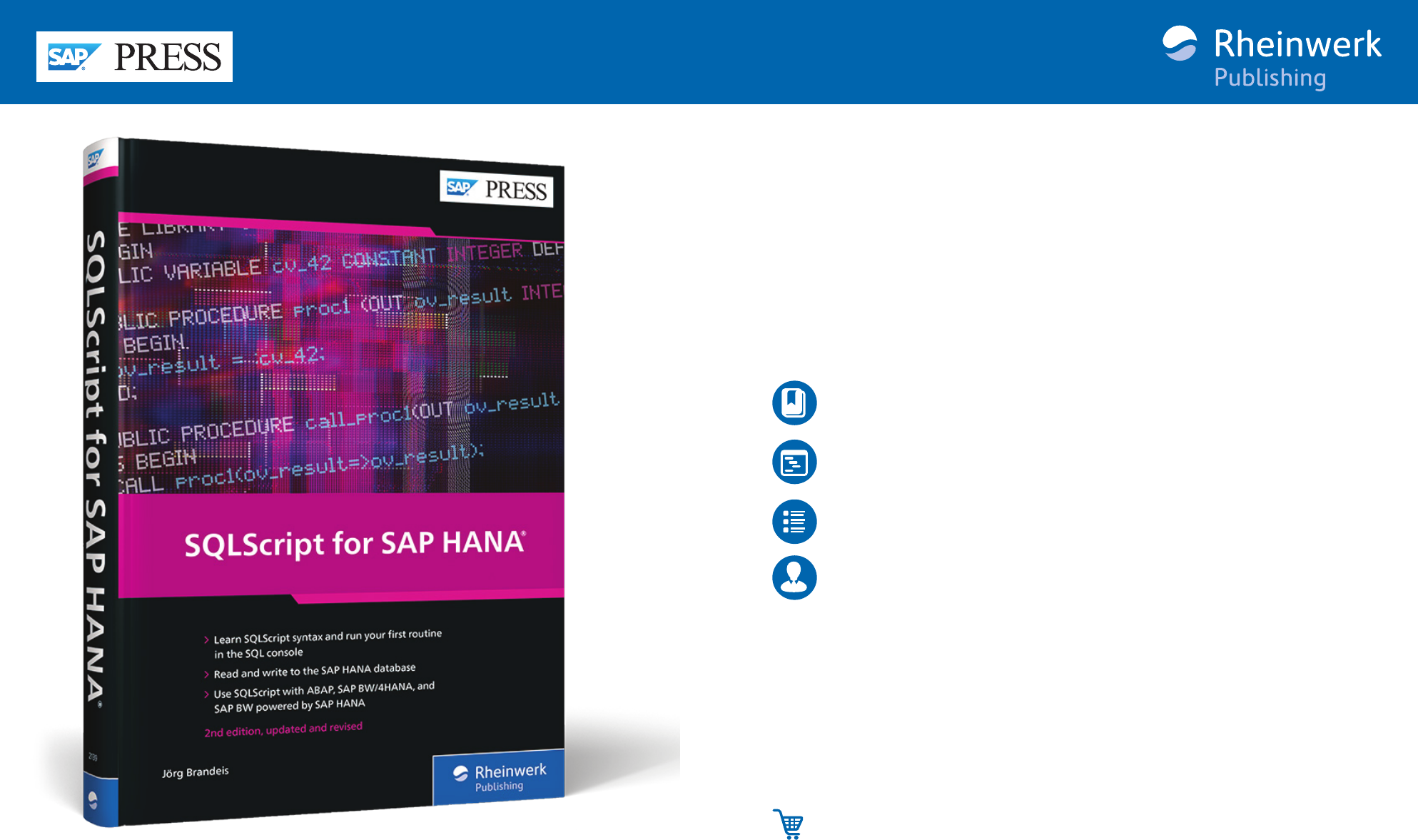
Browse the Book
This sample chapter demonstrates the techniques for using SQLScript
procedures for ABAP programs. It starts with the most important concept,
AMDP, followed by the other development objects of the AMDP frame-
work. The end of this chapter briefly shows you an alternative to AMPD
and give some basic recommendations for using database procedures
in ABAP programs.
Jörg Brandeis
SQLScript for SAP HANA
387 pages, 2nd, updated and revised edition 2021, $79.95
ISBN978-1-4932-2139-4
www.sap-press.com/5336
First-hand knowledge.
“SQLScript in ABAP Programs”
Contents
Index
The Author

283
8
Chapter 8
SQLScript in ABAP Programs
To enable the use of SQLScript from within ABAP programs, various
options are available, for example, the ABAP-managed database proce-
dures (AMDP) framework or table functions. In this chapter, we’ll provide
you an overview of these techniques.
In previous chapters, you learned how to write effective SQLScript source
code. You can use various options to call this source code from within the
SAP NetWeaver ABAP platform. From the ABAP perspective, SQLScript basi-
cally is Native SQL, which is how all database-specific SQL dialects are
described. The opposite of Native SQL is Open SQL, which is part of the ABAP
programming language. Open SQL is database-independent and is trans-
lated into the corresponding Native SQL at runtime.
Consider Other Database Systems
If you use Native SQL in ABAP, the corresponding programs and classes are
restricted for use in a particular database system. To be compatible for
multiple database systems, you must develop along several tracks. Accord-
ingly, you should create different implementations for the various SQL
variants. In this chapter, we’ll focus on following a two-track approach in
our examples, using both techniques:
쐍 SQLScript for SAP HANA databases
쐍 Open SQL for all other databases
In the following section, you will learn the techniques for using SQLScript
procedures for ABAP programs. We’ll start with the most important con-
cept, AMDP, followed by the other development objects of the AMDP
framework. And at the end of this chapter, we will briefly show you an alter-
native to AMPD and give some basic recommendations for using database
procedures in ABAP programs.
8.1 AMDP Procedures
From the point of view of an ABAP developer, an AMDP procedure is a
method of an ABAP class, which is implemented in the SQLScript

284
8 SQLScript in ABAP Programs
programming language. Being a method solves several problems, such as
the following:
쐍 The SQL procedure is called as a method call of an ABAP class. As a result,
the procedure call is perfectly integrated in ABAP.
쐍 The transport of the database procedure is performed using the ABAP
class rather than requiring several transport mechanisms that must be
kept in sync.
쐍 At the time of development, the developer does not need direct access to
the SAP HANA database with the appropriate authorizations. Working
with the usual ABAP developer authorizations with the ABAP develop-
ment tools is sufficient.
In the following sections, the terms AMDP and AMDP procedure are used
interchangeably. If not explicitly mentioned, the information doesn’t refer
to AMDP functions.
Before we jump into using AMDP, however, we’ll first provide you with an
initial introduction to some of the concepts of AMDP.
8.1.1 Introduction to AMDP
AMDP The term ABAP-managed database procedure (AMDP) stands for the frame-
work recommended by SAP for using SQLScript code in ABAP programs.
This concept serves as the basis for creating, managing, and calling data-
base procedures and functions. The basic idea behind AMDP is that the
source code of SAP HANA database objects can be wrapped in an imple-
mentation of methods of an ABAP class. The corresponding SAP HANA
database object is then generated from this implementation when
required.
Three different objects can be created with the AMDP framework:
쐍 AMDP procedures can be called like methods of an ABAP class. These pro-
cedures are implemented in SQLScript. The caller of the method doesn’t
know that the procedure is actually a database procedure.
쐍 Core data services (CDS) table functions are AMDP functions that are
encapsulated by a CDS object and can therefore be called from ABAP or
Open SQL like a normal database view via a
SELECT query.
쐍 AMDP functions for AMDP methods can’t be called directly from ABAP or
Open SQL. However, these functions can be used when implementing
other AMDP objects in SQLScript source code.
Table 8.1 compares the most important properties of the three objects.
285
8.1 AMDP Procedures
8
AMDP Framework
With the release of SAP NetWeaver 7.4 Support Package Stack (SPS) 05,
AMDPs were introduced as a framework for managing and calling data-
base procedures in the SAP HANA database.
With the release of SAP NetWeaver 7.5, AMDP functions have been added
to this concept. Although these functions are technically not procedures,
but functions, the name AMDP is also used for them.
AMDP classes are classes that implement the interface
IF_AMDP_MARKER_
HDB
and that contain at least one AMDP method.
AMDP methods can be either AMDP procedures or AMDP functions. AMDP
functions either implement a CDS table function, or AMDP functions are
available internally for other AMDP methods.
ToolsThe AMDP framework provides ABAP developers with extensive options
for implementation according to the code-to-data paradigm. Direct access
to the SAP HANA database is not absolutely necessary since all develop-
AMDP Procedure CDS Table Function AMDP Function
Call from
ABAP
Like an ABAP
method
In a SELECT state-
ment
Not possible
Implementa-
tion
In a static or
instance method
In PUBLIC, static
method of a static
class
In a static or
instance method
Two-track
development
Inheritable Possible by case
distinction
Not relevant, since
only callable from
other AMDP meth-
ods
Type of data
access
Read and write Read-only Read-only
Where are the
parameters
defined?
When you define
the method
When you define
the CDS object
When you define
the method
Type of
parameters
Any IMPORTING,
EXPORT, and
CHANGE
Any scalar IMPORT-
ING
and exactly
one table-like
RETURNING param-
eter
Any scalar IMPORT-
ING
and exactly
one table-like
RETURNING param-
eter
Table 8.1 Comparison of the Three AMDP Objects

286
8 SQLScript in ABAP Programs
ment objects can be implemented via the ABAP development tools in the
Eclipse development environment. You can also use a debugger for the
SQLScript code in the AMDP methods. This AMDB debugger is described in
more detail in Chapter 11, Section 11.2.3.
If SAP HANA data models such as calculation views are modeled or if proce-
dures and functions are developed outside the AMDP framework, direct
database access with corresponding authorizations will be necessary. The
Eclipse plug-ins from SAP HANA Studio must also be installed.
Benefits of AMDP When does using SQLScript in an ABAP program make sense? No general
answer exists for this question. Basically, the use of AMDPs makes sense
above all when significant performance improvements can be achieved,
which is particularly the case in the following scenarios:
쐍 If using SQLScript prevents the transport of large amounts of data
between the database and SAP NetWeaver Application Server (AS).
쐍 If the SQLScript procedure is programmed declaratively and can there-
fore be easily parallelized and optimized by the SAP HANA database.
쐍 If transformations with routines are to be executed directly in the SAP
HANA database in SAP Business Warehouse (SAP BW). Data transfer pro-
cesses will be accelerated considerably, regardless of whether the previ-
ous ABAP code worked with database access or not.
Disadvantages But the use of AMDPs also has a few disadvantages. You must always con-
sider whether you want to accept these disadvantages for the expected per-
formance improvements. The following reasons, among others, speak
against the use of AMDPs:
쐍 The application developer must be proficient in several programming
languages. Sometimes, a well-implemented ABAP method is better than
a poorly implemented AMDP.
쐍 SAP GUI is not suitable for developing AMDPs.
쐍 The application logic is distributed between the database server and SAP
NetWeaver Application Server (AS).
쐍 Performance is not improved in all cases.
쐍 AMDP developments can’t be used in other database systems. For a suit-
able procedure for parallel development, still leveraging the advantages
of SAP HANA with AMDPs, Section 8.1.5.
Alternatives You should always evaluate the alternatives before using AMDPs, includ-
ing, for example, CDS views and the extended features of Open SQL of the
latest SAP NetWeaver releases. According to the SAP documentation (http://
s-prs.co/v533626), AMDPs should only be used if database-specific functions,
such as the SQL function for currency conversion, is required but not avail-
287
8.1 AMDP Procedures
8
able in Open SQL, or if the transport of large amounts of data between the
database server and SAP NetWeaver Application Server (AS) must be
avoided.
SPACE and the Empty Character String
In ABAP, a global constant SPACE, of length 1, contains exactly one blank
character. This constant is often used for selecting data, for example, in
the following
WHERE clause:
WHERE recordmode = SPACE
In fact, however, the database doesn’t store the space character, but an
empty string of length 0. ABAP therefore does not distinguish between an
empty string and a single space character.
However, SQLScript does distinguish between these two strings. For use in
an ABAP system, SAP has introduced the
ABAPVARCHAR mode. This mode
converts all string literals with exactly one blank character into an empty
string in SQLScript as well, as in the following query:
SELECT session_context( 'ABAPVARCHARMODE' ) FROM DUMMY
Furthermore, you can test whether this mode is switched on. Since this
mode is controlled by the session variable
ABAPVARCHAR, you can also turn
this mod on and off in the code, as shown in Listing 8.1.
DO BEGIN
SET 'ABAPVARCHARMODE' = 'true';
SELECT length(' '),
'->' || ' ' || '<-' FROM dummy;
SET 'ABAPVARCHARMODE' = 'false';
SELECT length(' '),
'->' || ' ' || '<-' FROM dummy;
END;
Listing 8.1 Testing the ABAP VARCHAR mode
The result depends on the mode set. If you really need exactly one space as
a string in SQLScript, use the expression
CHAR(32).
8.1.2 Creating AMDP Procedures
IF_AMDP_MARKER_
HDB
You can create an AMDP method only in a global class, which implements
the marker interface
IF_AMDP_MARKER_HDB. The interface itself has no meth-
ods; it serves exclusively to mark AMDP classes.

288
8 SQLScript in ABAP Programs
An AMDP class can include both normal ABAP methods and AMDP meth-
ods. Whether a method is implemented as AMDP is not specified in the
method declaration. Listing 8.2 shows an example.
CLASS zcl_amdp_demo DEFINITION
PUBLIC
CREATE PUBLIC .
PUBLIC SECTION.
INTERFACES if_amdp_marker_hdb.
TYPES gty_tt_countries TYPE TABLE OF t005t .
METHODS get_countries
IMPORTING
VALUE(iv_langu) TYPE langu
EXPORTING
VALUE(et_country) TYPE gty_tt_countries
CHANGING
VALUE(cv_subrc) TYPE sy-subrc.
ENDCLASS.
CLASS zcl_amdp_demo IMPLEMENTATION.
METHOD get_countries
BY DATABASE PROCEDURE FOR HDB LANGUAGE SQLSCRIPT
USING t005t.
et_country = select *
from t005t
where spras = :iv_langu;
SELECT CASE
WHEN COUNT(*) > 0
THEN 0
ELSE 4
END AS subrc
INTO cv_subrc
FROM :et_country;
ENDMETHOD.
ENDCLASS.
Listing 8.2 Example of a Simple AMDP Method
Restrictions on the
method signature
An SQLScript procedure is generated at a later time from the source code of
an AMDP method. However, these database procedures are more restrictive
289
8.1 AMDP Procedures
8
with regard to parameters than ABAP methods. Accordingly, the following
restrictions must of course also apply to AMDP methods:
쐍 First, all parameters must be completely typed. Generic data types such
as
TYPE TABLE or REF TO DATA are not permitted.
쐍 Since SQLScript doesn’t know any structures, only scalar data types and
table types may be used as parameters. The table types can only use sca-
lar data types in their row structure.
쐍 All parameters must be transferred as value parameters (call by value);
you can’t use any reference parameters (call by reference). The reason for
this restriction is obvious when you consider that the application server
is running on a different system than the database. Accordingly, no
shared memory area exists that both systems reference.
쐍 You can only use IMPORTING, EXPORTING, and CHANGING parameters with
AMDP procedures. The use of
RETURNING parameters is not possible.
쐍 Only AMDP exception classes can be declared in the signature of the
method. These exception classes are the subclasses of
CX_AMDP_ERROR. If
these exception classes are declared, the caller of the AMDP method can
handle these exceptions. However, if not declared, these errors result in
a dump.
Implementing
an AMDP
AMDP procedures are developed in the SQLScript language, which is indi-
cated to the system by the addition
BY DATABASE PROCEDURE FOR HDB LANGUAGE
SQLSCRIPT.
If an AMDP implementation only reads data, you can optionally specify the
addition
OPTIONS READ-ONLY.
USINGThe optional addition USING enables you to tell an AMDP implementation
that you want to use the corresponding tables, views, AMDP functions, or
AMDP procedures from the default database schema of the SAP NetWeaver
system. Thus, you can use this name without having to explicitly specify
the relevant database schema in the SQLScript source code. The objects are
only separated by whitespaces and listed after the keyword
USING. Note that
this code is still ABAP code. If, for example, you specify a table generated by
SAP BW from the generation namespace,
/BIC/ or /BI0/, you do not need to
use any quotation marks, for example:
...USING /BI0/PPLANT.
If you access this table in SQLScript code, however, you must use special
notation, since the slash is not permitted in simple notation, as in the fol-
lowing:
SELECT ... FROM "/BI0/PPLANT".
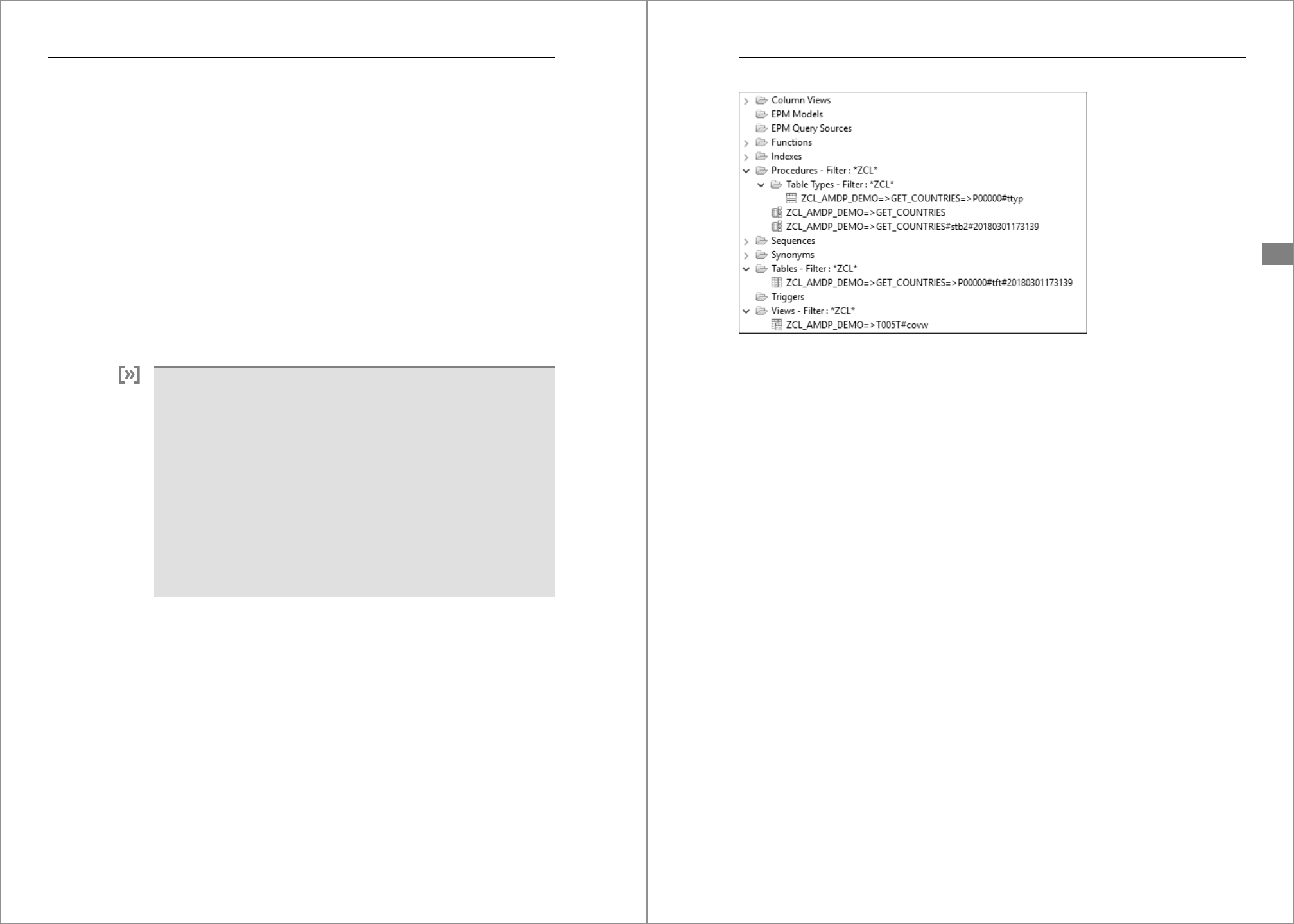
290
8 SQLScript in ABAP Programs
USING for
AMDP objects
The use of AMDP procedures and functions is declared in the USING clause
via the name of the associated ABAP method using the notation
CLASS=
>METHOD. Listing 8.3 contains an example of the keywords in the METHOD
clause of the method implementation. Everything after the period in line 5
up to the keyword
ENDMETHOD is interpreted as SQLScript.
1 METHOD get_countries
2 BY DATABASE PROCEDURE FOR HDB
3 LANGUAGE SQLSCRIPT
4 OPTIONS READ-ONLY
5 USING t005t.
6
7 <SQLScript-Code>
8 ENDMETHOD.
Listing 8.3 Keywords for Implementing an AMDP Method
A General Concept for a Specific Database
Basically, all instructions and declarations in connection with AMDP are
designed in such a way that AMDPs can be implemented in different data-
base systems and in different languages. Accordingly, the implementation
of AMDP methods also includes the mandatory entries
FOR <databasesys-
tem> and LANGUAGE <querylanguage>.
However, to date (SAP NetWeaver 7.51), only implementations for the SAP
HANA database with the SQLScript language are possible. The language L
may only be used within SAP.
The other database systems under SAP NetWeaver each have their own
programming languages, such as Oracle’s PL/SQL language. However,
these languages can’t be used to implement AMDPs.
8.1.3 Generated Objects of an AMDP Method
An ABAP class serves as an envelope for the code of the AMDP procedure.
Some SAP HANA database objects are automatically generated from this
class. Figure 8.1 shows the objects generated by the procedure found in List-
ing 8.2.
Note that a table type, two procedures, a database table, and a view have
been generated for an AMDP method. Each object has its own special tasks,
which we’ll explain next.
291
8.1 AMDP Procedures
8
Figure 8.1 Generated Objects of an AMDP Procedure
The Generated AMDP Procedure
The procedure ZCL_AMDP_DEMO=>GET_COUNTRIES contains the actual SQLScript
source code. However, the code has been slightly modified, as shown in
Listing 8.4.
CREATE PROCEDURE
"ZCL_AMDP_DEMO=>GET_COUNTRIES"
(
IN "IV_LANGU" NVARCHAR (000001),
OUT "EV_SUBRC" INTEGER,
IN "CT_COUNTRY__IN__" "ZCL_AMDP_DEMO=>GET_COUNTRIES=>P00000#
ttyp",
OUT "CT_COUNTRY" "ZCL_AMDP_DEMO=>GET_COUNTRIES=>P00000#ttyp"
)
LANGUAGE sqlscript SQL SECURITY INVOKER
AS BEGIN
"CT_COUNTRY" = select * from :CT_COUNTRY__IN__ ;
BEGIN
lt_countries = SELECT land1 FROM :CT_COUNTRY;
et_country = SELECT t5.*
FROM "ZCL_AMDP_DEMO=>T005T#covw" AS t5
INNER JOIN :LT_COUNTRIES AS countries
ON t5.land1 = countries.land1
WHERE t5.spras = :IV_LANGU;
SELECT CASE
WHEN COUNT(*) > 0

292
8 SQLScript in ABAP Programs
THEN 0
ELSE 4
END AS subrc
INTO ev_subrc
FROM :CT_COUNTRY;
END;
END;
Listing 8.4 Source Code of Procedure ZCL_AMDP_DEMO=>GET_COUNTRIES
Parameter list The relevant passages in the source code are highlighted in bold type. First,
you’ll see the parameter list. Notice that the
CHANGING parameter CT_COUNTRY
occurs twice. This repetition occurs because, in SQLScript, an INOUT parame-
ter must have a scalar type. Thus, in addition to the
OUT parameter CT_COUN-
TRY, the IN parameter CT_COUNTRY__IN__ is created. In the first line after AS
BEGIN, the parameter CT_COUNTRY is filled with the contents of CT_COUNTRY__
IN__
, which simulates the behavior of a CHANGING parameter.
Table Types for the Table Parameters
In the parameter interface of an SQLScript procedure, all parameters must
be typed. In the case of table parameters, corresponding table types are cre-
ated for AMDP procedures. In our example,
CT_COUNTRY is typed using the
generated table type
ZCL_AMDP_DEMO=>GET_COUNTRIES =>P00000#ttyp.
USING Views
Each access to a table declared via USING is encapsulated by a view. In our
example, this view is the database view
ZCL_AMDP_DEMO =>T005T#covw, which
replaces direct access to table
T005T. The task of the view is to compensate
for any field sequences that differ between the ABAP Dictionary and the
database object.
Stub Procedure
In addition to the actual AMDP procedure, a second procedure is generated,
which is named according to the name pattern
<AMDPprocedure>#stb2#
<timestamp>
. Accordingly, in our example, the procedure name is ZCL_AMDP_
DEMO=>GET_COUNTRIES#stb2#20180301173139.
This procedure serves as a stub for the call from SAP NetWeaver. The time-
stamp (Section 8.1.4) is used for versioning purposes in case the object
changes.
293
8.1 AMDP Procedures
8
The source code shown in Listing 8.5 involves only two parameters: IV_
LANGU
and EV_SUBRC. The CHANGING table parameter CT_COUNTRIES is not part of
the parameter definition of the procedure.
Return of the tableThe return of the table CT_COUNTRIES is not carried out via an explicitly
defined table parameter but via the result set of the procedure. After the call
of the AMDP procedure, a
SELECT query is executed to the table CT_COUN-
TRIES.
CREATE PROCEDURE
"ZCL_AMDP_DEMO=>GET_COUNTRIES#stb2#20180301173139"
(
IN "IV_LANGU" NVARCHAR (000001),
OUT "EV_SUBRC" INTEGER
)
LANGUAGE sqlscript SQL SECURITY INVOKER AS BEGIN
"CT_COUNTRY__IN__" = SELECT * FROM "ZCL_AMDP_DEMO=>GET_COUNTRIES=
>P00000#tft#20180301173139" ;
CALL "ZCL_AMDP_DEMO=>GET_COUNTRIES" (
"CT_COUNTRY__IN__" => :CT_COUNTRY__IN__ ,
"IV_LANGU" => :IV_LANGU ,
"EV_SUBRC" => :EV_SUBRC ,
"CT_COUNTRY" => :CT_COUNTRY
);
SELECT * FROM :CT_COUNTRY;
END;
Listing 8.5 Source Code of the Stub Procedure
Input Tables as Global Temporary Tables
The values of table parameters are transferred into the stub procedure via
generated, global temporary tables. Before the actual AMDP procedure is
called, the table variables are initialized from the global temporary table. In
our example,
CT_COUNTRIES is filled from the global temporary table in the
following way:
"CT_COUNTRY__IN__" = SELECT * FROM "ZCL_AMDP_DEMO=>GET_COUNTRIES=>
P00000#tft#20180301173139"
Here again, a timestamp is part of the name.
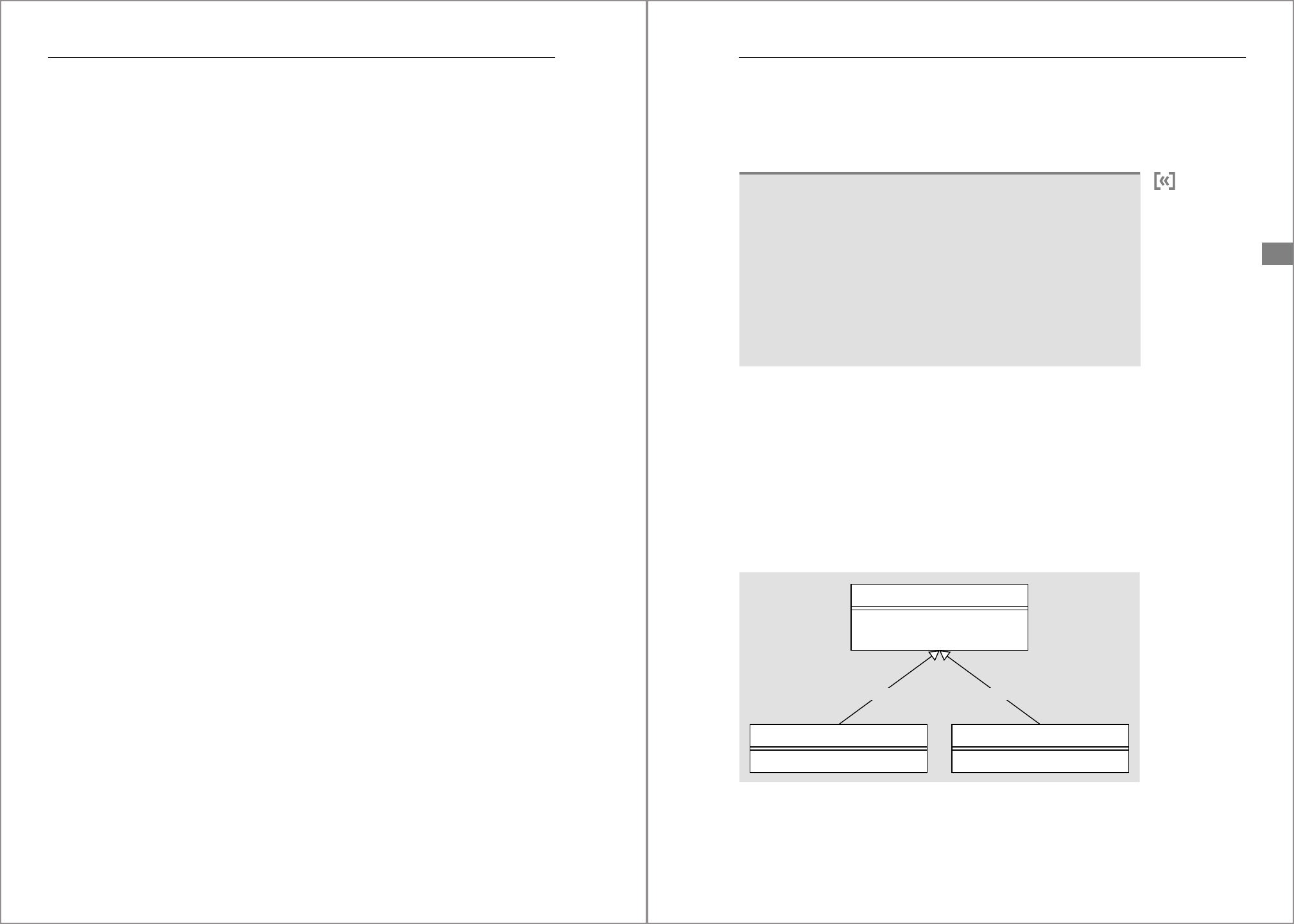
294
8 SQLScript in ABAP Programs
8.1.4 Lifecycle of the Generated Objects
The lifecycle of the AMDP classes and methods is not identical to the lifecy-
cle of their corresponding SAP HANA objects. In the following sections,
we’ll describe the effects of various actions carried out in the SAP
NetWeaver Application Server (AS) on the corresponding SAP HANA
objects:
Object lifecycles 쐍 Creating and activating an AMDP class
Creating and activating an AMDP class with an AMDP method doesn’t
generate any database objects. Thus, you can transport AMDP classes to
SAP NetWeaver systems without an SAP HANA database. If an SAP HANA
database is available as the central database system, the database objects
are temporarily created and immediately deleted again for the syntax
check.
쐍 Executing an AMDP method
Database objects, introduced in the previous section, are generated
during the first execution of the AMDP method. The timestamp in the
object’s name refers to the activation time of the class.
Even if a class contains several AMDP methods, only the objects for the
executed methods are generated.
쐍 Repeated editing and activation of an AMDP class
The stub procedures for all AMDP procedures are deleted when the class
is reactivated. The same applies to all generated AMDP procedures that
have changed. The generated global temporary table will remain for the
time being.
The next time the program is executed, the objects are created again
with the new timestamp. Since global temporary tables are not deleted
immediately, some objects with different timestamps can still exist at
the same time.
쐍 Deleting an AMDP class
The generated objects on SAP HANA are deleted upon the deletion of the
AMDP class.
The late generation of SAP HANA objects means that transporting AMDP
classes in a mixed system landscape can run smoothly. Versioning of
changes is carried out using timestamps to ensure that the correct version
of a procedure is always called.
8.1.5 Two-Track Development
There are different reasons why you would want both an ABAP and an AMDP
implementation of a method. From a technical point of view, developing
295
8.1 AMDP Procedures
8
both is not a problem, since whether a method is written in SQLScript or
ABAP is only determined when the method is implemented and doesn’t
affect the definition of the method. In the following sections, we’ll look at a
few typical use cases where more than one implementation exists.
Clean Code: Separation of Concerns
The principle of the separation of concerns was formulated in 1974 by Eds-
ger W. Dijkstra. Under this principle, different tasks should also be per-
formed by different components in a system. In our case, separation of
concerns means that database access should not be mixed with other
application code. Instead, different classes should be created for each
aspect.
If you adhere to this principle, two-track development of AMDP and ABAP
implementations is also relatively simple. Classes for database access can
be easily exchanged.
Support of Different Database Systems
If the application needs to run on different database systems, you can have
one implementation in Open SQL and one in AMDP. Of course, you can also
create special implementations for each of the other databases.
Switching between
implementations
Switching between the various implementations should take place auto-
matically at runtime. For this purpose, you can use the factory design pat-
tern. As shown in Figure 8.2, we’ll use a static factory method,
GET_INSTANCE,
to generate the instances. Based on the
SY-DBSYS field, this method decides
which class implementation should be used.
Figure 8.2 UML Diagram for Two Implementations of Database Access with a
Static Factor Method
ZCL_READ_XYZ_OSQL
+ EXECUTE( ): Table of data
ZCL_READ_XYZ_AMDP
+ EXECUTE( ): Table of data
ZCL_READ_XYZ
+ EXECUTE( ): Table of data
+ GET_INSTANCE( ): ZCL_READ_XYZ
Extends Extends
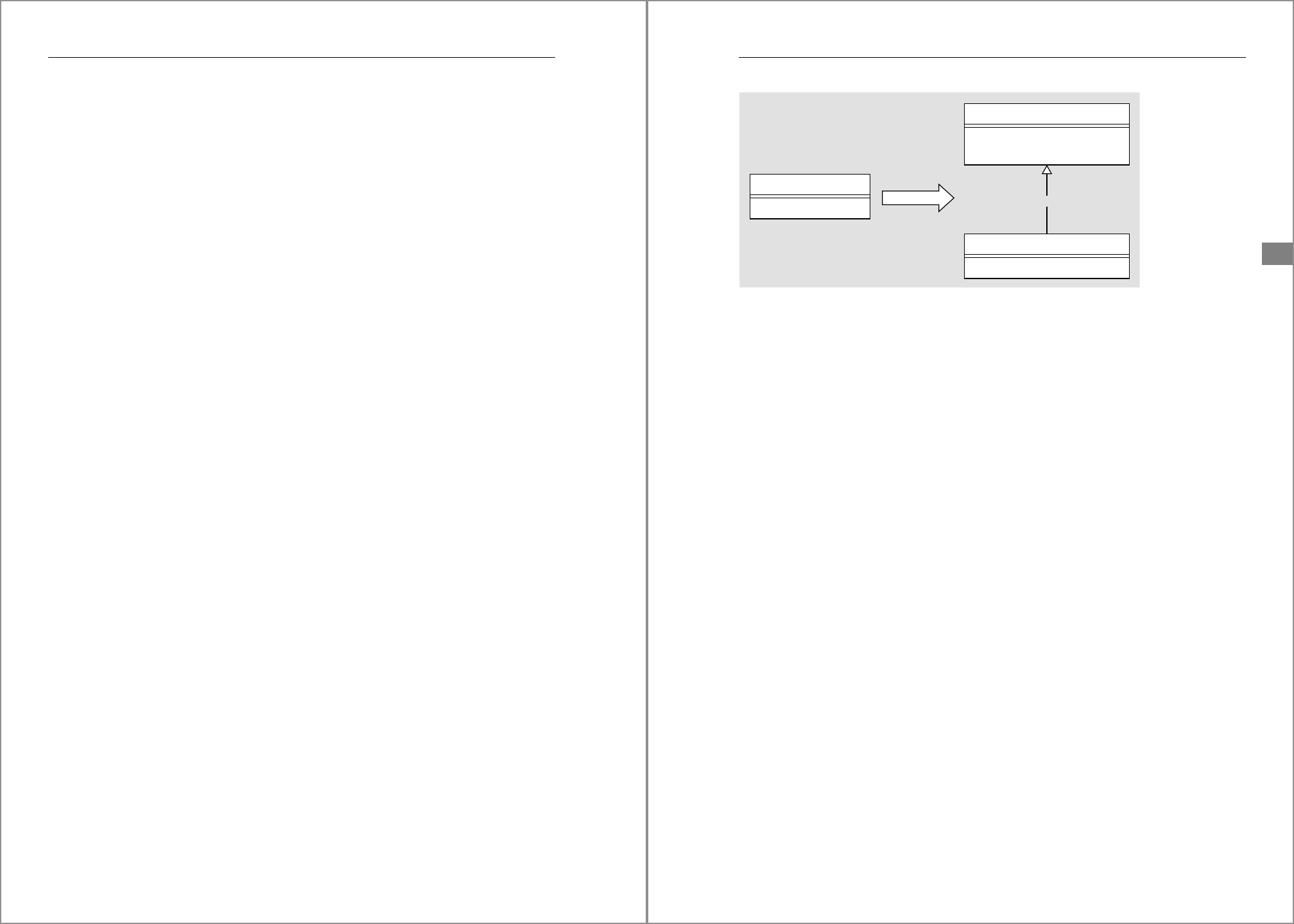
296
8 SQLScript in ABAP Programs
Listing 8.6 shows a simple implementation of the method GET_INSTANCE. Of
course, other database systems could also be considered.
METHOD get_instance.
DATA lv_classname TYPE classname.
CASE sy-dbsys.
WHEN 'HDB'.
lv_classname = 'ZCL_READ_XYZ_AMDP'.
WHEN OTHERS.
lv_classname = 'ZCL_READ_XYZ_OSQL'.
ENDCASE.
CREATE OBJECT ro_instance TYPE (lv_classname).
ENDMETHOD.
Listing 8.6 Static Factory Method GET_INSTANCE in ABAP
Comparison between ABAP and AMDP
If you want to test the differences between the implementations in ABAP
and AMDP in runtime and result, inheritance is rather useful concept as in,
for example, the previous section where we leveraged inheritance from a
shared superclass. However, you’ll need a suitable switch that allows you
the flexibility to select the relevant implementation. You can create these
switches, for example, by using entries in a Customizing table or by defin-
ing user parameters. These switches can then be queried in a corresponding
factory method.
Retroactive Implementation as AMDP
Let’s say you implemented a method in ABAP and later discover perfor-
mance problems; you can implement the method as an AMDP. To preserve
the original implementation for performance and result comparisons, cre-
ating a subclass is a good idea. The corresponding method is then imple-
mented as an AMDP in this subclass.
Refactoring Due to restrictions on AMDPs regarding access to instance attributes and
parameters, this procedure must be taken into account when creating your
methods. Alternatively, you can carry out a refactoring, as shown in Figure
8.3, by following this approach:
1. Outsource the logic into a new method that meets the requirements of
an AMDP: no access to class and instance data, no
RETURNING parameters,
no parameters with structures.
2. Create a subclass.
3. Redefine the corresponding method as an AMDP.
297
8.1 AMDP Procedures
8
Figure 8.3 Outsourcing the Logic to an AMDP-Compatible Method and
Redefinition
To switch between the two versions of the class, you can use a factory
method again.
ABAP Unit Tests
A mock object is often used to insert data into a class to be tested in a unit
test. This object has the same external interface as a real object but provides
predefined data that is independent of the database state. Classes that con-
tain an AMDP can, for example, be replaced for unit tests by a local subclass
in which the AMDP method has been replaced by a corresponding ABAP
implementation. For such tests, you can use the dependency injection
design pattern.
Only in global
classes
Note that AMDP implementation is only possible in global classes. In local
classes, only an implementation in ABAP is allowed.
8.1.6 Using AMDP Procedures in Other AMDP Procedures
An AMDP method generates a corresponding database procedure the first
time it is executed (see also Section 8.1.4). This database procedure can of
course also be called directly in any SQLScript code, especially in other
AMDP procedures. Thus, a certain modularization of the programs is possi-
ble without direct development access to the database.
ExampleListing 8.7 shows a simple example of calling an AMDP procedure in
another AMDP method. Note that a
CHANGING parameter in the AMDP
method has the following two associated parameters in the corresponding
database table, as described in Section 8.1.3:
MY_CLASS_AMDP
# AMDP_SUITABLE_METHOD_X( )
MY_CLASS
+ METHOD_X( )
MY_CLASS
+ METHOD_X( )
# AMDP_SUITABLE_METHOD_X( )
Extends
Refactoring

298
8 SQLScript in ABAP Programs
쐍 CT_PRICE
쐍 CT_PRICE__IN__
In this case, you must assign these parameters yourself in order to call the
procedure correctly.
Avoid CHANGING Table Parameters
In the database procedure, the CHANGING table parameters are imple-
mented in two parameters. As shown in Listing 8.7, the code needed for a
direct call of this procedure can look confusing to untrained readers
because the
CT_PRICES__IN__ parameter was not defined anywhere in the
ABAP class. If you use these two parameters instead, the code will be more
readable:
쐍 IT_PRICES for entering the table
쐍 ET_PRICES for the output of the table
If the generated procedures are only called using ABAP methods, whether
or not you use
CHANGING table parameters doesn’t matter.
CLASS zcl_amdp_call DEFINITION PUBLIC.
PUBLIC SECTION.
TYPES: BEGIN OF ty_s_price,
item TYPE numc4,
net_price TYPE wertv9,
gross_price TYPE wertv9,
vat TYPE wertv9,
curr TYPE waers,
END OF ty_s_price.
TYPES ty_t_price TYPE STANDARD TABLE OF ty_s_price.
INTERFACES if_amdp_marker_hdb.
METHODS calculate_vat
IMPORTING
VALUE(iv_vat) TYPE int1
CHANGING
VALUE(ct_price) TYPE ty_t_price.
METHODS calculate_gross_price
IMPORTING
299
8.1 AMDP Procedures
8
VALUE(iv_vat) TYPE int1
CHANGING
VALUE(ct_price) TYPE ty_t_price.
ENDCLASS.
CLASS zcl_amdp_call IMPLEMENTATION.
METHOD calculate_gross_price BY DATABASE PROCEDURE
FOR HDB LANGUAGE SQLSCRIPT
USING zcl_amdp_call=>calculate_vat.
CALL "ZCL_AMDP_CALL=>CALCULATE_VAT"(
iv_vat => :iv_vat,
ct_price => :ct_price,
ct_price__in__ => :ct_price );
ct_price = SELECT item,
net_price,
net_price + vat as gross_price,
vat,
curr,
FROM :ct_price;
ENDMETHOD.
METHOD calculate_vat BY DATABASE PROCEDURE
FOR HDB LANGUAGE SQLSCRIPT.
ct_price = SELECT item,
net_price,
gross_price,
net_price * :iv_vat / 100 as vat,
curr,
FROM :ct_price;
ENDMETHOD.
ENDCLASS.
Listing 8.7 Calling an AMDP Procedure from Another AMDP Method
USINGAll AMDP procedures used must be declared in an AMDP method via USING,
which ensures that the necessary database objects are generated as
required. Note that the class constructor of the AMDP classes used is called
before the method is executed.
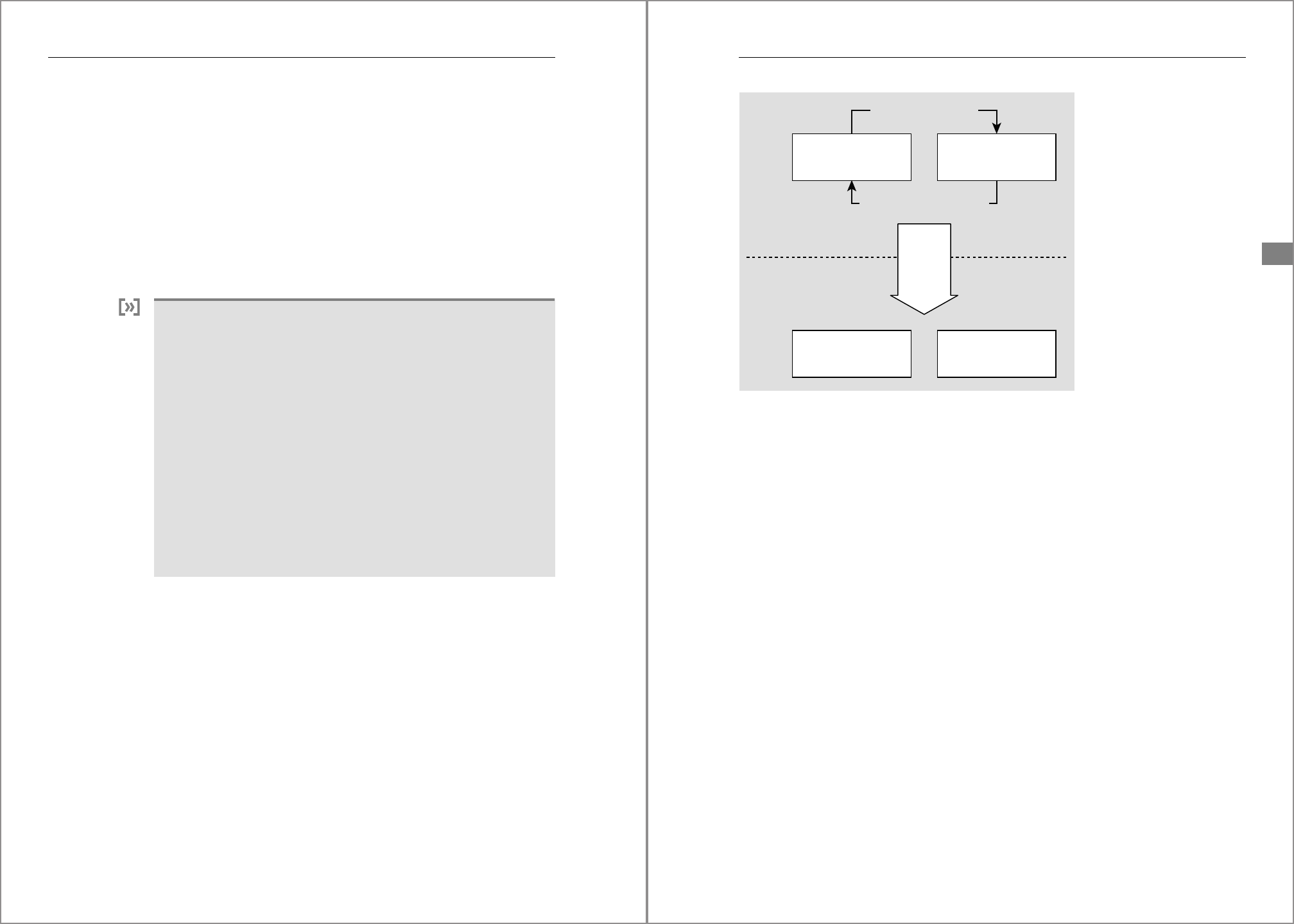
300
8 SQLScript in ABAP Programs
8.2 CDS Table Functions
A CDS table function is an AMDP function that provides table data and can
be consumed from ABAP in Open SQL, like a database view.
Implementation The implementation of a CDS table function is similar to an AMDP proce-
dure as a method of an ABAP class. A corresponding user-defined function
is then generated from this method in the SAP HANA database. Since user-
defined functions can’t be consumed directly in Open SQL, the AMDP func-
tions are encapsulated by a CDS object. An AMDP function can therefore
also be considered a programmed CDS view. The CDS object can then be
used normally, such as a database view, in Open SQL.
Core Data Services
The classic ABAP Dictionary manages database objects such as data types
(data elements, structures, table types); database tables; and views. The
definitions of these objects are stored and managed in a database-neutral
form in the associated database tables (
DD*) at the ABAP application server
level. Depending on the database system used, the appropriate database
objects are then generated from the stored definition. The classic ABAP
Dictionary, which can be called via Transaction SE11, only allows the limited
use of the SQL options, especially for views.
CDS are a common concept that exists both directly in the SAP HANA data-
base and on the SAP NetWeaver AS ABAP. With CDS, database objects such
as views or table functions can be defined with the help of their own lan-
guage, which is based on the data definition language (DDL) of SQL. These
data models can be enriched with semantic information using annota-
tions.
8.2.1 Creating a CDS Table Function
To create a CDS table function, two related objects must be created:
쐍 The CDS table function is defined in a DDL source with the parameters
and the table type of the return table. This step implicitly defines the sig-
nature of the associated AMDP method.
쐍 The AMDP function is implemented in a method of a static ABAP class.
This step contains the SQLScript source code for the table function.
Interaction Figure 8.4 shows the interaction between a CDS table function and an
AMDP function.
301
8.2 CDS Table Functions
8
Figure 8.4 Objects Involved in a CDS Table Function
CDS Table Function
CDS table functions
wizard
You can use a wizard to create CDS table functions from the ABAP develop-
ment tools of the Eclipse development environment. Start by clicking New 폷
Other ABAP Repository Object in the context menu of the development
package and then choose Core Data Services 폷 Data Definition in the follow-
ing dialog. Figure 8.5 shows the corresponding wizard. To create a CDS table
function, you must select the Define Table Function with Parameters tem-
plate.
The wizard then generates a basic structure of the corresponding source
code of the CDS table function, as shown in Listing 8.8.
@EndUserText.label: 'Example for a table function'
define table function Z_CDS_TF
with parameters parameter_name : parameter_type
returns {
client_element_name : abap.clnt;
element_name : element_type;
}
implemented by method class_name=>method_name;;
Listing 8.8 Basic Structure of the Definition of a CDS Table Function
SAP NetWeaver
Application Server for ABAP
SAP HANA
CDS Table Function AMDP Function
User-Dened Fields
Function
USING Views
IMPLEMENTED BY …
FOR TABLE FUNCTION …
Generate
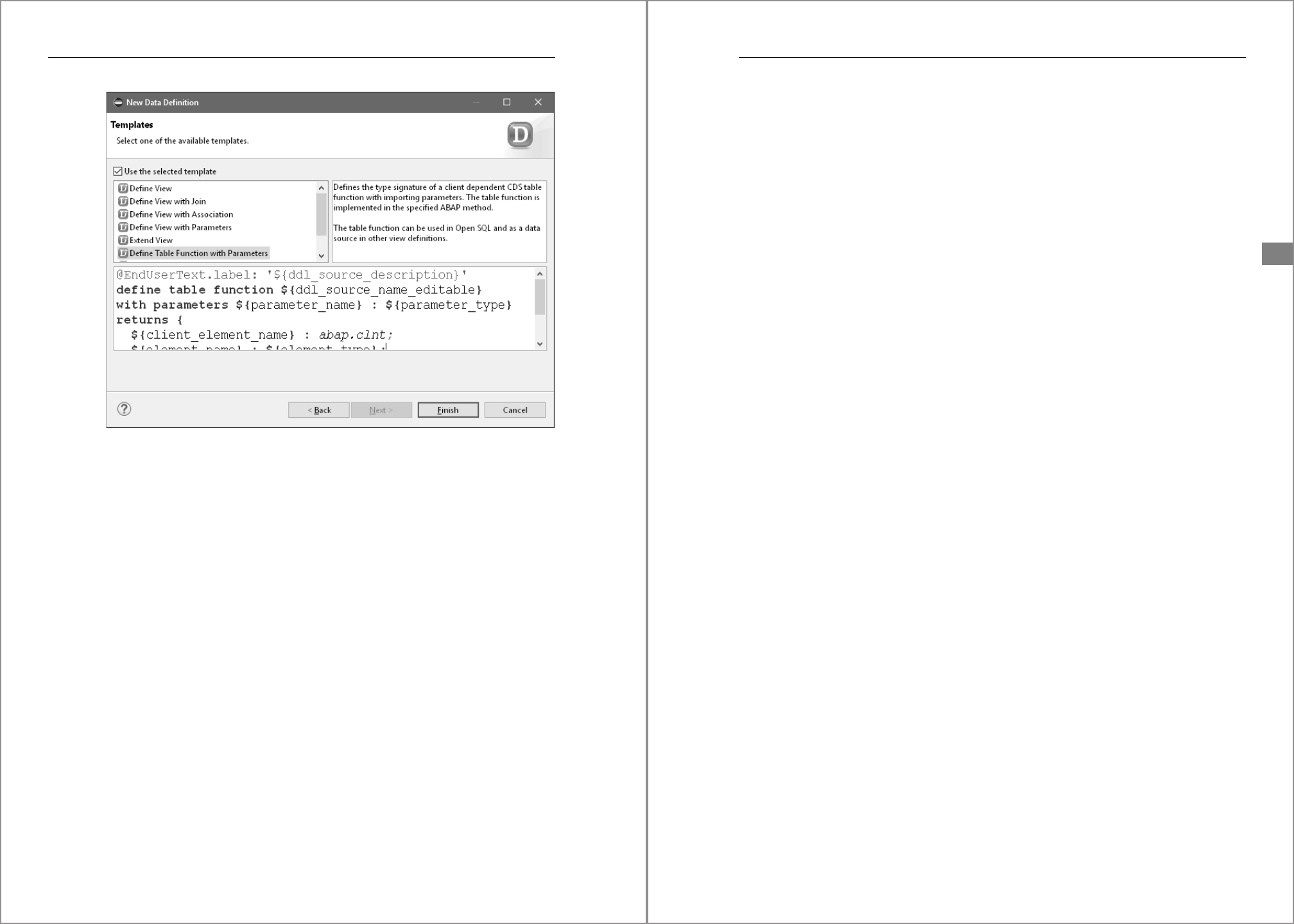
302
8 SQLScript in ABAP Programs
Figure 8.5 Wizard for Creating CDS Objects
In this section, we’ll describe only a rudimentary syntax for defining CDS
objects, which are not the focus of the book. For more information on CDS
objects, we recommend the SAP document “SAP HANA Core Data Services
(CDS) Reference,” at http://s-prs.co/v533627.
Components The definition of the CDS table function consists of the following compo-
nents:
쐍 @EndUserText.label
This annotation contains the descriptive text for the CDS table function
previously specified in the wizard.
쐍 define table function <CDS_entity>
This component indicates the start of the definition of the CDS table
function. The name of the CDS entity is in the same namespace as the
data types of the ABAP Dictionary. Therefore, a CDS entity must not have
the same name as, for example, a database table.
쐍 with parameters <parameterlist>
If the CDS table function will have parameters, these parameters can be
defined in this component. The use of parameters is optional. The client
is often specified as a parameter, which will allow you to select data by
client in the function, as shown in Listing 8.10.
303
8.2 CDS Table Functions
8
쐍 returns { <fieldlist> }
The field list defines the structure of the return table. If the CDS table
function is client-dependent, the first field must have the ABAP Dictio-
nary type
CLNT. For example, you can use the data element MANDT.
쐍 implemented by method <classname>=><methodname>
This component tells the CDS table function by which AMDP method the
implementation is performed. The CDS entity can be activated if the
associated method doesn’t exist yet.
AMDP Function
The actual implementation of the CDS table function occurs an AMDP
method in a static, global ABAP class, which requires the implementation of
the marker interface
IF_AMDP_MARKER_HDB. Unlike AMDP procedures, AMDP
functions for CDS table functions are static methods. The parameters are
not defined individually in the method definition. Instead, you’ll use the
addition
FOR TABLE FUNCTION <CDS_table_function_name> to establish the ref-
erence to the associated CDS table function. The parameters defined in the
CDS entity are then available in the function implementation.
The method implementation must be structured as shown in Listing 8.9.
METHOD <method_name> BY DATABASE FUNCTION
FOR HDB LANGUAGE SQLSCRIPT
OPTIONS READ-ONLY
[USING <usages>].
<SQLScript-Code>
ENDMETHOD.
Listing 8.9 Structure of the Implementation of an AMDP Function for a CDS
Table Function
The additions in the METHOD statement are all mandatory except for the
USING specification. The use of USING in this context is similar as in AMDP
procedures.
Example of a CDS Table Function
For a functioning CDS table function, the definition of the CDS entity and
the implementation of the AMDP function belong together.
DefinitionListing 8.10 and Listing 8.11 contain some simple examples to show the
basics of CDS table functions using texts for countries read from table
T005T. In practice, your CDS table functions will be used for much more
complex scenarios that utilize multiple features of the SAP HANA database
and SQLScript.

304
8 SQLScript in ABAP Programs
@EndUserText.label: 'Country texts'
define table function z_country_text
with parameters
@Environment.systemField: #CLIENT mandt:mandt,
@Environment.systemField: #SYSTEM_LANGUAGE sy_langu:langu
returns {
mandt:mandt;
country:land1;
text:landx50;
}
implemented by method zjb_cl_country=>get_country_text;
Listing 8.10 Example of Defining a CDS Table Function
The client and language are taken from the system fields via the annotation
@Environment.systemField.
RETURN statement The implementation shown in Listing 8.11 consists of only a RETURN state-
ment, which returns the result of a
SELECT query.
CLASS zjb_cl_country DEFINITION PUBLIC.
PUBLIC SECTION.
INTERFACES if_amdp_marker_hdb.
CLASS-METHODS get_country_text
FOR TABLE FUNCTION z_country_text.
ENDCLASS.
CLASS zjb_cl_country IMPLEMENTATION.
METHOD get_country_text BY DATABASE FUNCTION
FOR HDB LANGUAGE SQLSCRIPT
OPTIONS READ-ONLY
USING t005t.
RETURN SELECT mandt,
land1 AS country,
landx50 AS text
FROM t005t
WHERE spras = :sy_langu
AND mandt = :mandt;
ENDMETHOD.
ENDCLASS.
Listing 8.11 Example of Implementing a CDS Table Function
Testing You can test the CDS table function using a simple ABAP program, as shown
in Listing 8.12.
305
8.2 CDS Table Functions
8
REPORT zjb_test .
SELECT *
FROM z_country_text
INTO TABLE @DATA(lt_country)
##db_feature_mode[amdp_table_function].
cl_demo_output=>display( lt_country ).
Listing 8.12 ABAP Program for Testing the CDS Table Function from the Example
Notice that the CDS table function can be read with a SELECT query, much
like a database table or a view.
Two-Track Implementation
You cannot create alternative implementations in ABAP or Open SQL for
CDS table functions. However, if your program needs to run on SAP HANA
as well as on other database systems, the caller of the CDS table function
must take care of an alternative implementation. To query at runtime
whether CDS table functions are available, you can use the
CL_ABAP_
DBFEATURES class. As shown in Listing 8.13, this class can be queried for the
existence of the used feature
AMDP_TABLE_FUNCTION.
IF cl_abap_dbfeatures=>use_features(
VALUE #( ( cl_abap_dbfeatures=>amdp_table_function ) ) ).
* Implementation with CDS table function
ELSE.
* Alternative implementation without SAP HANA features
ENDIF.
Listing 8.13 Checking the Availability of CDS Table Functions
The syntax check also indicates with a warning that database-dependent
functions are used when querying CDS table functions. You can use the
following pragma to disable the warning, as shown in Listing 8.12.
##db_feature_mode[amdp_table_function]
This pragma signals to the syntax check that the developer is aware that
this query will lead to errors in other database systems.
8.2.2 Generated Objects of a CDS Table Function
User-defined
function
As with AMDP procedures, database objects can also be generated in SAP
HANA for CDS table functions. First, a user-defined function is assigned the
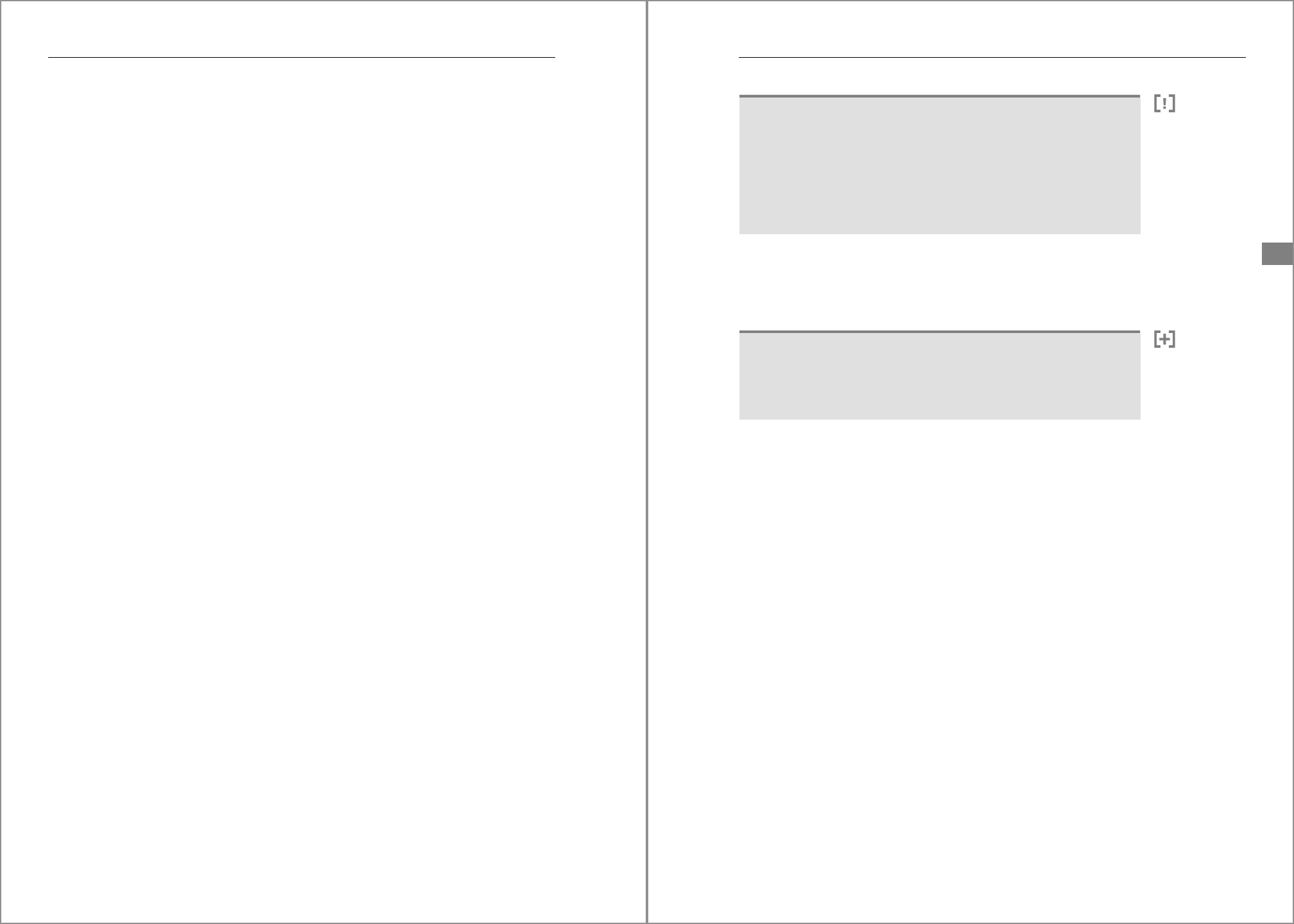
306
8 SQLScript in ABAP Programs
same name as the associated static method of the AMDP function, as
shown in Listing 8.14.
create function
"ZJB_CL_COUNTRY=>GET_COUNTRY_TEXT"
(
"MANDT" NVARCHAR (000003),
"SY_LANGU" NVARCHAR (000001)
)
returns table
(
"MANDT" NVARCHAR (000003) ,
"COUNTRY" NVARCHAR (000003) ,
"TEXT" NVARCHAR (000050)
)
language sqlscript sql security invoker as begin
RETURN SELECT mandt,
land1 AS country,
landx50 AS text
FROM "ZJB_CL_COUNTRY=>T005T#covw"
WHERE spras = :SY_LANGU
AND mandt = :MANDT;
end;
Listing 8.14 Generated User-Defined Function for the AMDP Function
As with AMDP procedures, a view was also generated for the table specified
via
USING.
8.2.3 Implicit Client Handling of CDS Table Functions
By default, the implicit client handling of CDS table functions is enabled.
Thus, the first field in the field list must be of dictionary type
CLNT. Accord-
ingly, the developer must also ensure that this field is filled out correctly
with the source client of the data. In a
SELECT query to the CDS table func-
tion, all data with other clients are then implicitly filtered out.
To improve performance, you should filter out the data of other clients in
the AMDP function. To create a filter, you’ll define an input parameter for
the client, which is then automatically assigned the correct client via the
annotation @Environment.systemField: #CLIENT. The examples shown in
Listing 8.10 and Listing 8.11 illustrate the correct client handling.
307
8.3 AMDP Functions for AMDP Methods
8
Note the Client in the Join Condition
As an ABAP developer, you may not be accustomed to taking the client into
account since this task is usually undertaken by Open SQL. In SQLScript,
however, the client is only an ordinary database field. Be sure you make
the correct selection yourself, in particular for join conditions. If you don’t
select the client in this situation, the cartesian product of the data is
formed over all existing clients.
Client independentIf implicit client handling is not desired, you can disable it using the anno-
tation
@ClientDependent: false. Nevertheless, you can still have the client as
a field in the return structure of the CDS table function and select it as for
any other field.
Use Implicit Client Handling If Possible
Application and Customizing data are typically client specific. Thus, you
should always use the implicit the client handling feature of the CDS table
function.
8.3 AMDP Functions for AMDP Methods
If AMDP functions are only to be used in SQLScript source code by other
AMDP methods, defining an associated CDS table function is not necessary.
The definition and implementation of an AMDP function for AMDP meth-
ods differs in the following aspects:
쐍 The AMDP method can be a static method or an instance method. There-
fore, the associated AMDP classes don’t have to be static.
쐍 The method can also be declared in the private or protected visibility
area.
쐍 The parameters of the method are defined when the method is defined.
쐍 The addition FOR TABLE FUNCTION in the method definition is omitted.
8.3.1 AMDP Table Functions
AMDP table functions have been available in ABAP since SAP NetWeaver
7.40. They are defined with a fully typed, table-like
RETURNING parameter. In
the implementation, the result table must then be returned with the
RETURN
<table expression> statement.

308
8 SQLScript in ABAP Programs
AMDP functions
in different
AMDP methods
Listing 8.15 contains an example using an AMDP table function in a differ-
ent AMDP method. The direct call of the method
GET_COUNTRY_TEXT in an
ABAP method of the class
ZCL_AMDP_FUNC would not be possible.
CLASS zcl_amdp_func DEFINITION PUBLIC.
PUBLIC SECTION.
TYPES: BEGIN OF ty_s_country,
mandt TYPE mandt,
country TYPE land1,
text TYPE landx50,
END OF ty_s_country.
TYPES ty_t_country TYPE STANDARD TABLE OF ty_s_country
WITH DEFAULT KEY.
INTERFACES if_amdp_marker_hdb.
METHODS test_amdp_table_function
IMPORTING VALUE(iv_langu) TYPE langu
VALUE(iv_mandt) TYPE mandt
EXPORTING VALUE(et_country) TYPE ty_t_country.
PRIVATE SECTION.
METHODS get_country_text
IMPORTING VALUE(iv_langu) TYPE langu
VALUE(iv_mandt) TYPE mandt
RETURNING VALUE(rt_country) TYPE ty_t_country.
ENDCLASS.
CLASS zcl_amdp_func IMPLEMENTATION.
METHOD test_amdp_table_function BY DATABASE PROCEDURE
FOR HDB LANGUAGE SQLSCRIPT
OPTIONS READ-ONLY
USING zcl_amdp_func=>get_country_text.
et_country = select *
from "ZCL_AMDP_FUNC=>GET_COUNTRY_TEXT"
( iv_langu => :iv_langu,
iv_mandt => :iv_mandt);
ENDMETHOD.
METHOD get_country_text BY DATABASE FUNCTION
FOR HDB LANGUAGE SQLSCRIPT
OPTIONS READ-ONLY
USING t005t.
309
8.3 AMDP Functions for AMDP Methods
8
RETURN SELECT mandt,
land1 AS country,
landx50 AS text
FROM t005t
WHERE spras = :iv_langu
AND mandt = :iv_mandt;
ENDMETHOD.
ENDCLASS.
Listing 8.15 Example of Using an AMDP Table Function in a Different AMDP
Method
8.3.2 Scalar AMDP Functions
With SAP_BASIS component release 753, scalar functions can also be imple-
mented in the AMDP framework. In the definition, these functions differ
only in the scalar return type of the function. In the implementation, the
result is then not returned with the
RETURN statement, but the return
parameter is simply assigned.
We explored the structure of an AMDP function in connection with CDS
table functions earlier in Listing 8.9. For scalar AMDP functions, you can
also specify the
DETERMINISTIC option after OPTIONS if the same output is
always generated for the same input. This step allows the results of the sca-
lar function to be buffered from the database.
Listing 8.16 shows an example of a scalar function that cleans up values for
InfoObjects that are not allowed in an SAP BW system. Note that, although
this function finds and replaces most characters disallowed in SAP BW sys-
tems, other characters may cause problems.
CLASS zjb_bw_tools_amdp DEFINITION
PUBLIC
FINAL
CREATE PUBLIC .
PUBLIC SECTION.
INTERFACES if_amdp_marker_hdb.
METHODS replace_unallowed_characters
IMPORTING VALUE(iv_input) TYPE rschavl60
RETURNING VALUE(rv_output) TYPE rschavl60.
ENDCLASS.
CLASS zjb_bw_tools_amdp IMPLEMENTATION.

310
8 SQLScript in ABAP Programs
METHOD replace_unallowed_characters BY DATABASE FUNCTION
FOR HDB LANGUAGE SQLSCRIPT
OPTIONS READ-ONLY.
rv_output = CASE WHEN LEFT( :iv_input,1)='!'
THEN replace( iv_input ,'!' , '$')
WHEN :iv_input = '#'
THEN ''
ELSE :iv_input
END;
rv_output = replace_regexpr( '[[:cntrl:]]'
IN :rv_output WITH '' );
rv_output = replace( :rv_output, nchar( '0130'), '');
ENDMETHOD.
ENDCLASS.
Listing 8.16 Example of a Scalar AMDP Function
Performance of Scalar Functions
In general, scalar functions run the risk of having a negative impact on per-
formance. With the function shown in Listing 8.16, you can easily clean up
dozens of fields in a transformation routine in the SAP BW system. How-
ever, large amounts of data can quickly lead to performance problems.
Before using any scalar function, therefore, you should test them with
realistic data volumes to determine whether the scalar function is suffi-
ciently fast.
8.4 Alternatives to AMDP for Calling SQLScript Code from
ABAP Programs
With the AMDP framework, calling SQLScript can be elegantly integrated
into the ABAP language and Open SQL. A person reading an ABAP program
may not initially recognize that AMDP objects are actually hidden behind a
method call or a presumed table.
Alternative
techniques
However, with alternative techniques, you can execute SQLScript state-
ments from ABAP programs. These techniques may be necessary if second-
ary database connections will be used and can be helpful when executing
dynamic SQL code.
However, you can call SQLScript code from ABAP without using AMDPs in
several alternative ways:
311
8.5 Recommendations
8
쐍 ABAP Database Connectivity (ADBC)
ADBC is a class-based framework for running Native SQL. Individual SQL
statements, database connections, and result sets are represented as
ABAP objects. ADBC can be regarded as a successor to the static embed-
ding of Native SQL using the
EXEC SQL statement in ABAP code. In more
than name only, the ADBC framework is reminiscent of the similarly
structured Java Database Connectivity (JDBC) from the Java world.
쐍 EXEC SQL <Native SQL> ENDEXEC
This statement enables you to embed Native SQL statically into the ABAP
source code. However, SAP no longer recommends this approach.
Instead, ADBC is referenced for the use of Native SQL.
쐍 CALL DATABASE PROCEDURE
This ABAP statement allows you to call any database procedure on SAP
HANA via an associated proxy object. However, SAP recommends using
AMDPs instead, as long as the procedure will be called via the primary
database connection.
8.5 Recommendations
In this chapter, you learned some ways to directly access the objects of an
SAP HANA database in your programs. Even if trying out these new tech-
niques is tempting, let’s pause a moment to review some final consider-
ations:
쐍 If possible, you should continue to use Open SQL, as long as no signifi-
cant performance improvements are foreseeable. The ABAP language
has been extended in recent releases to include powerful functions, such
as the use of expressions and the option of combining multiple queries
via
UNION. More complex queries can also be mapped using CDS views.
쐍 However, if, for performance reasons or other considerations, executing
SQLScript code directly from ABAP programs still seems necessary, the
techniques of the AMDP framework on the SAP HANA database are the
weapon of choice for executing static SQLScript code.
쐍 If you need dynamic SQLScript code, ADBC is the right technique. How-
ever, dynamic SQL code is always problematic. On one hand, error analy-
sis is often more difficult, and on the other hand, you must guard against
security gaps and vulnerability to SQL injection attacks.
쐍 If you’re working with secondary database connections, you should con-
sider using a
CALL DATABASE PROCEDURE statement. Further, the autono-
mous transactions we discussed in Chapter 6, Section 6.6.2, can also
solve some classic use cases for secondary database connections more
elegantly.

312
8 SQLScript in ABAP Programs
Regardless of the technology used, the clean encapsulation of the database
access is always recommended in both AMDP and Open SQL. Only if you
bundle and encapsulate the database access in separate classes will you
have the necessary flexibility to carry out optimizations later without fear
of negative side effects.
8.6 Summary
Code execution on the SAP HANA database system can be extremely fast,
which you can effectively take advantage of with the concepts learned in
this chapter. With the AMDP framework, you have in your hands a tool that
allows you to easily create and call database procedures and functions. In
the next chapter, you’ll learn how this framework is used by SAP BW to
implement transformation routines in SQLScript.

7
Contents
Introduction ....................................................................................................................15
1 SAP HANA 21
1.1 What Is SAP HANA? ...................................................................................... 22
1.1.1 SAP HANA: A Fast SQL Database ............................................... 22
1.1.2 SAP HANA: An Application Server ............................................. 26
1.1.3 SAP HANA: A Collection of Tools ............................................... 27
1.2 System Architecture ..................................................................................... 29
1.2.1 SAP HANA Server Components .................................................. 29
1.2.2 Databases and Tenants ................................................................ 30
1.3 Organizing Database Objects .................................................................. 32
1.3.1 Database Schemas ......................................................................... 32
1.3.2 Database Catalogs ......................................................................... 34
1.3.3 Content and Repositories ............................................................ 35
1.4 Development Environments .................................................................... 36
1.4.1 SAP HANA Studio ............................................................................ 37
1.4.2 SAP HANA Database Explorer .................................................... 40
1.5 The SQL Console ............................................................................................. 44
1.6 Summary ........................................................................................................... 47
2 Getting Started with SQLScript 49
2.1 SQL versus SQLScript .................................................................................... 49
2.2 Basic Language Elements ........................................................................... 53
2.2.1 Statements ....................................................................................... 53
2.2.2 Whitespace ....................................................................................... 54
2.2.3 Comments ........................................................................................ 54
2.2.4 Literals ................................................................................................ 56
2.2.5 Identifiers .......................................................................................... 58
2.2.6 Access to Local Variables and Parameters ............................. 59
2.2.7 System Variables ............................................................................ 60
2.2.8 Reserved Words .............................................................................. 61
2.2.9 Operators .......................................................................................... 61
2.2.10 Expressions ....................................................................................... 63

8
Contents
2.2.11 Predicates .......................................................................................... 65
2.2.12 Data Types ......................................................................................... 66
2.2.13 The NULL Value ................................................................................ 67
2.2.14 The DUMMY Table .......................................................................... 69
2.3 Modularization and Logical Containers ............................................... 70
2.3.1 Blocks .................................................................................................. 72
2.3.2 Procedures ......................................................................................... 75
2.3.3 User-Defined Functions ................................................................ 83
2.3.4 User-Defined Libraries ................................................................... 87
2.4 Sample Program ............................................................................................. 89
2.4.1 Requirements ................................................................................... 89
2.4.2 Requirements Analysis .................................................................. 90
2.4.3 Implementation .............................................................................. 91
2.4.4 Testing the Implementation ....................................................... 97
2.5 Summary ............................................................................................................ 100
3 Declarative Programming in SQLScript 101
3.1 Table Variables ................................................................................................ 102
3.1.1 Declaring Table Variables ............................................................. 102
3.1.2 Using Table Variables .................................................................... 103
3.2 SELECT Statements ........................................................................................ 104
3.2.1 SELECT Clauses ................................................................................. 105
3.2.2 Field List of SELECT Clauses ......................................................... 105
3.2.3 FROM Clauses ................................................................................... 119
3.2.4 Joins ..................................................................................................... 122
3.2.5 WHERE Conditions ......................................................................... 130
3.2.6 WITH Clauses ................................................................................... 137
3.2.7 GROUP BY Clauses .......................................................................... 139
3.2.8 HAVING Clauses .............................................................................. 141
3.2.9 ORDER BY Clauses ........................................................................... 142
3.2.10 Set Theory .......................................................................................... 143
3.2.11 Subqueries ......................................................................................... 145
3.2.12 Alias Names ...................................................................................... 146
3.3 Other Operators .............................................................................................. 148
3.3.1 Calculation Engine Plan Operators ........................................... 148
3.3.2 MAP_MERGE Operator .................................................................. 149
3.3.3 MAP_REDUCE Operator ................................................................ 150
3.4 Summary ............................................................................................................ 151
9
Contents
4 Data Types and Their Processing 153
4.1 Character Strings ........................................................................................... 153
4.1.1 Data Types for Character Strings .............................................. 154
4.1.2 Conversions ...................................................................................... 157
4.1.3 Character String Functions ......................................................... 157
4.1.4 SQLSCRIPT_STRING Library ......................................................... 171
4.2 Date and Time ................................................................................................. 176
4.2.1 Date Information ............................................................................ 176
4.2.2 Time Information ........................................................................... 181
4.2.3 Combined Time and Date Information ................................... 182
4.2.4 Processing Time and Date Values ............................................. 182
4.2.5 Examples of Processing Time Values ....................................... 187
4.3 Numerical Data ............................................................................................... 189
4.3.1 Basic Arithmetic Operations ....................................................... 191
4.3.2 Square Roots and Exponents ...................................................... 191
4.3.3 Logarithms ........................................................................................ 192
4.3.4 Rounding or Trimming ................................................................. 192
4.3.5 Trigonometry ................................................................................... 194
4.3.6 Random Numbers .......................................................................... 194
4.3.7 Sign ...................................................................................................... 194
4.3.8 Quantities and Amounts ............................................................. 195
4.4 Binary Data Types .......................................................................................... 200
4.4.1 Conversion between Binary Data, Hexadecimal Data,
and Character Strings ................................................................... 201
4.4.2 Bits and Bytes .................................................................................. 202
4.5 Conversions between Data Types .......................................................... 204
4.6 Summary ........................................................................................................... 205
5 Write Access to the Database 207
5.1 INSERT ................................................................................................................. 208
5.1.1 Individual Data Records ............................................................... 208
5.1.2 Inserting Multiple Records Simultaneously .......................... 209
5.2 UPDATE .............................................................................................................. 211
5.2.1 Simple UPDATE Statement ......................................................... 211
5.2.2 UPDATE Statement with Reference to Other Tables .......... 212

10
Contents
5.3 UPSERT or REPLACE ........................................................................................ 213
5.3.1 Inserting or Updating Individual Data Records .................... 213
5.3.2 Inserting or Updating Multiple Data Records ....................... 214
5.4 MERGE INTO ..................................................................................................... 214
5.5 DELETE ................................................................................................................. 217
5.6 TRUNCATE TABLE ............................................................................................ 217
5.7 Summary ............................................................................................................ 217
6 Imperative Programming 219
6.1 Variables ............................................................................................................ 219
6.1.1 Local Scalar Variables .................................................................... 219
6.1.2 Local Table Variables ..................................................................... 224
6.1.3 Session Variables ............................................................................ 234
6.1.4 Temporary Tables ........................................................................... 235
6.2 Flow Control Using IF and ELSE ................................................................ 236
6.3 Loops .................................................................................................................... 239
6.3.1 FOR Loop ............................................................................................ 239
6.3.2 WHILE Loop ....................................................................................... 240
6.3.3 Controlling Loop Passes ................................................................ 241
6.3.4 Exercise: Greatest Common Divisor ......................................... 242
6.4 Cursors ................................................................................................................ 243
6.4.1 FOR Loop via a Cursor .................................................................... 243
6.4.2 Open, Read, and Close Explicitly ................................................ 244
6.4.3 Updateable Cursors ........................................................................ 246
6.5 Arrays ................................................................................................................... 246
6.5.1 Generating an Array ....................................................................... 247
6.5.2 Accessing the Array ........................................................................ 247
6.5.3 Arrays as Local Variables .............................................................. 248
6.5.4 Splitting and Concatenating Arrays ......................................... 249
6.5.5 Arrays and Table Columns ........................................................... 250
6.5.6 Bubble Sort Exercise ....................................................................... 251
6.6 Transaction Control ....................................................................................... 253
6.6.1 Transactions ..................................................................................... 253
6.6.2 Autonomous Transactions .......................................................... 254
6.7 Executing Dynamic SQL ............................................................................... 255
6.7.1 Parameters of Dynamic SQL ........................................................ 257
6.7.2 Input Parameters ............................................................................ 258
11
Contents
6.8 Error Handling ................................................................................................. 260
6.8.1 What Are Exceptions? ................................................................... 261
6.8.2 Triggering Exceptions ................................................................... 262
6.8.3 Catching Exceptions ...................................................................... 262
6.9 Summary ........................................................................................................... 266
7 Creating, Deleting, and Editing
Database Objects 267
7.1 Tables .................................................................................................................. 268
7.1.1 Creating Database Tables ............................................................ 268
7.1.2 Changing Database Tables ......................................................... 272
7.1.3 Deleting Database Tables ............................................................ 273
7.2 Table Types ....................................................................................................... 273
7.3 Views ................................................................................................................... 274
7.4 Sequences ......................................................................................................... 276
7.4.1 Increment .......................................................................................... 277
7.4.2 Limits .................................................................................................. 277
7.4.3 Behavior When Reaching the Limit .......................................... 277
7.4.4 Resetting the Sequence ................................................................ 278
7.4.5 Changing and Deleting a Sequence ......................................... 278
7.5 Triggers .............................................................................................................. 278
7.5.1 Parameters ....................................................................................... 280
7.5.2 Per Row or Per Statement ............................................................ 281
7.6 Summary ........................................................................................................... 281
8 SQLScript in ABAP Programs 283
8.1 AMDP Procedures .......................................................................................... 283
8.1.1 Introduction to AMDP ................................................................... 284
8.1.2 Creating AMDP Procedures ......................................................... 287
8.1.3 Generated Objects of an AMDP Method ................................ 290
8.1.4 Lifecycle of the Generated Objects ........................................... 294
8.1.5 Two-Track Development .............................................................. 294
8.1.6 Using AMDP Procedures in Other AMDP Procedures ......... 297
8.2 CDS Table Functions ..................................................................................... 300
8.2.1 Creating a CDS Table Function .................................................. 300

12
Contents
8.2.2 Generated Objects of a CDS Table Function .......................... 305
8.2.3 Implicit Client Handling of CDS Table Functions ................. 306
8.3 AMDP Functions for AMDP Methods .................................................... 307
8.3.1 AMDP Table Functions .................................................................. 307
8.3.2 Scalar AMDP Functions ................................................................. 309
8.4 Alternatives to AMDP for Calling SQLScript Code from
ABAP Programs
............................................................................................... 310
8.5 Recommendations ......................................................................................... 311
8.6 Summary ............................................................................................................ 312
9 SQLScript in SAP Business Warehouse 313
9.1 Executing the Data Transfer Process in ABAP vs. SAP HANA ..... 314
9.2 Transformation Routines as AMDP ........................................................ 318
9.2.1 Creating Transformation Routines in Eclipse ........................ 318
9.2.2 Creating Transformation Routines in SAP GUI ..................... 319
9.3 Successive Transformations and Mixed Execution ......................... 320
9.4 Generated AMDP Classes ........................................................................... 321
9.4.1 Signature of AMDP Methods ...................................................... 323
9.4.2 Assigning the Output Tables ...................................................... 325
9.4.3 Access to Data from Other Data Models ................................ 325
9.5 Individual Routines ....................................................................................... 328
9.5.1 Start Routines ................................................................................... 329
9.5.2 End Routines ..................................................................................... 329
9.5.3 Expert Routines ............................................................................... 330
9.5.4 Field Routines ................................................................................... 332
9.6 Error Processing and Error Stack .............................................................. 333
9.6.1 Processing Flow in the Data Transfer Process ....................... 335
9.6.2 Example: Recognizing Incorrect Data in Table OUTTAB .... 336
9.6.3 Example: Finding Invalid Field Contents with Regular
Expressions ....................................................................................... 337
9.7 Summary ............................................................................................................ 337
13
Contents
10 Clean SQLScript Code 339
10.1 Code Readability ............................................................................................ 339
10.1.1 Formatting the Code ..................................................................... 340
10.1.2 Mnemonic Names .......................................................................... 341
10.1.3 Granularity of Procedures and Functions ............................... 342
10.1.4 Comments ........................................................................................ 345
10.1.5 Decomposing Complex Queries ................................................ 347
10.1.6 Readable SQLScript Statements ................................................ 351
10.2 Performance Recommendations ............................................................ 352
10.2.1 Reducing Data Volumes ............................................................... 353
10.2.2 Avoid Switching between Row and Column Engines ........ 353
10.2.3 Declarative Queries ........................................................................ 353
10.2.4 Scalar Functions .............................................................................. 353
10.3 Summary ........................................................................................................... 354
11 Tests, Errors, and Performance Analysis 355
11.1 Testing SQLScript Code ............................................................................... 356
11.1.1 SQL Console ...................................................................................... 356
11.1.2 Testing ABAP-Managed Database Procedure Methods .... 358
11.1.3 SQLSCRIPT_LOGGING Library ..................................................... 359
11.1.4 End-User Test Framework in SQLScript ................................... 361
11.2 Debugger for SQLScript ............................................................................... 365
11.2.1 SQLScript Debugger in SAP HANA Studio ............................... 366
11.2.2 ABAP-Managed Database Procedure Debugger in
the ABAP Development Tools ..................................................... 369
11.2.3 Debugging in the SAP HANA Database Explorer ................. 372
11.3 Performance Analysis .................................................................................. 374
11.3.1 Runtime Measurement ................................................................ 374
11.3.2 Execution Plan ................................................................................. 375
11.3.3 Plan Visualizer ................................................................................. 377
11.3.4 SQL Analyzer of the SAP HANA Database Explorer ............. 384
11.3.5 SQLScript Code Analyzer .............................................................. 386
11.4 Summary ........................................................................................................... 390

14
Contents
Appendices 391
A Data Model for Task Management ........................................................ 393
B List of Abbreviations ..................................................................................... 397
CThe Author........................................................................................................ 399
Index ................................................................................................................................... 401

401
Index
A
ABAP ................................................................. 67
date format ............................................ 180
unit test .................................................... 297
ABAP Database Connectivity
(ABDC) ...................................................... 311
ABAP development tools ................... 36, 38
ABAP Dictionary ........................................ 300
ABAP_ALPHANUM() ................................ 157
ABAP_LOWER() .......................................... 159
ABAP_UPPER() ........................................... 159
ABAP-managed database procedure
(AMDP) ....................... 21, 55, 70, 284, 296
ABAP .......................................................... 296
classes ....................................................... 321
debugger ......................................... 369, 372
field routine ............................................ 332
framework .............................................. 285
function ................................. 284, 300, 307
implementing a procedure ............... 289
in ABDP procedure .............................. 297
method ............................................ 287, 297
objects ....................................................... 290
procedure ....................................... 283–284
PROCEDURE method .......................... 323
recommendations ............................... 311
retroactive implementation ............ 296
routines .................................................... 147
testing the method .............................. 358
tools ........................................................... 317
ABS() ............................................................... 194
ACOS() ............................................................ 194
ADD_*() ......................................................... 183
ADD_MONTHS_LAST() ........................... 184
ADD_MONTHS() ........................................ 184
ADD_WORKDAYS() .................................. 184
Advanced DataStore objects
(aDSOs) ............................................ 313, 326
Aggregate expression .............................. 111
Aggregate functions ....................... 111, 113
Alias ................................................................ 106
Alias name .......................................... 146, 212
Alignment .................................................... 341
Alpha conversion ...................................... 157
ALPHANUM ................................................ 155
ALTER TABLE ............................................... 272
Amount ......................................................... 195
Anonymous blocks ........................... 70, 102
ANSI SQL standard ....................................... 50
APPLY_FILTER ............................................. 259
Arithmetic operators .................................. 61
Array ............................................................... 246
access ........................................................ 247
as local variable .................................... 248
concatenate and split ......................... 249
generate ................................................... 247
table and .................................................. 250
ARRAY_AGG() ................................... 250–251
AS BEGIN ................................................... 80, 84
ASCII ...................................................... 154, 170
character set .............................................. 53
ASIN() ............................................................. 194
Assigning an output table ..................... 325
Asterisk .......................................................... 107
ATAN() ........................................................... 194
ATAN2() ......................................................... 194
Authorization control ................................ 33
Automatic number assignment ......... 270
Autonomous transaction ...................... 254
AVG ................................................................. 113
B
Basic arithmetic operations .................. 191
BEGIN
AUTONOMOUS TRANSACTION ...... 254
block ............................................................. 72
Best practices .............................................. 339
BETWEEN ...................................................... 132
Binary data ................................................... 202
Binary data type ......................................... 200
Binary floating-point number ............. 190
BINTOHEX() ................................................. 201
BINTONHEX() .............................................. 201
BINTOSTR() .................................................. 201
BITCOUNT() ................................................. 204
BITSET() ......................................................... 202
BITUNSET() ................................................... 202
Blank characters ........................................... 54
Blank line ...................................................... 340
BLOB ............................................................... 200
Blocks ................................................................ 72
anonymous ................................................ 74
comment ..................................................... 55
BREAK statement ...................................... 241

402
Index
Breakpoint ................................................... 370
Bring Your Own Language (BYOL) ......... 26
Bubble sort algorithm ............................. 251
C
Calculation engine .................................... 376
Calculation engine functions
(CE functions) ................................ 148, 387
Calendar week ............................................ 186
CALL ................................................................... 81
CALL DATABASE PROCEDURE ............. 311
CARDINALITY() ........................................... 246
CASCADE ....................................................... 273
CASE expressions ...................................... 108
searched ................................................... 109
simple ........................................................ 108
CAST() ............................................................. 204
CEIL() .............................................................. 193
CHANGING table parameters ............... 298
CHAR() ........................................................... 170
Character string ......................................... 153
data type .................................................. 154
function .................................................... 157
literals .......................................................... 57
search within .......................................... 165
Client capability ............................................ 31
Client concept ............................................. 197
Client handling .......................................... 306
CLOB ............................................................... 157
COALESCE function ..................................... 69
Code Analyzer ............................................. 386
Code Inspector ........................................... 389
Code optimization .................................... 354
Code pushdown ............................................ 52
Code-to-data paradigm .............................. 51
Colon ................................................................. 60
Column alias ............................................... 147
Column definition .................................... 268
Column engine .......................................... 376
Column list .................................................. 352
Column list UPSERT ................................. 213
Column name ............................................. 106
Column sequence ........................... 208–209
Column store ............................. 22, 270, 353
Column update .......................................... 215
Column-based storage ............................... 23
Commented out ........................................ 242
Comments ............................................ 54, 345
Commercial rounding ............................. 192
COMMIT ........................................................ 253
CompositeProvider .................................. 313
Compression .................................................. 23
CONCAT() ...................................................... 158
array .......................................................... 249
Concatenation ............................................ 158
Constants ........................................................ 88
Constraint ..................................................... 269
CONTAINS .................................................... 135
Content folder .............................................. 35
CONTINUE .................................................... 241
Control character ....................................... 337
Conversion
data type .................................................. 204
explicit ....................................................... 204
implicit ...................................................... 204
permissible .............................................. 204
CONVERT_CURRENCY() .......................... 198
CONVERT_UNIT() ...................................... 195
Core data services (CDS) ........................... 21
client .......................................................... 306
objects of a table function ................ 305
table function ............ 284, 300–301, 303
view ............................................................ 300
Correlation name ............................ 107, 352
COS() ............................................................... 194
COSH() ............................................................ 194
Cosine ............................................................. 194
COT() ............................................................... 194
COUNT ................................................. 112–113
CPU load .......................................................... 24
CREATE FUNCTION ..................................... 83
CREATE TABLE ............................................ 268
CREATE TABLE AS ...................................... 271
CREATE TABLE LIKE .................................. 271
Critical path ................................................. 380
Cross-join ...................................................... 123
Currency conversion ................................ 198
CURRENT_DATE ......................................... 183
CURRENT_LINE_NUMBER ....................... 61
CURRENT_OBJECT_NAME ....................... 60
CURRENT_OBJECT_SCHEMA .................. 60
CURRENT_TIME ......................................... 183
CURRENT_TIMESTAMP ........................... 183
CURRENT_UTCDATE ................................ 183
CURRENT_UTCTIME ................................. 183
CURRENT_UTCTIMESTAMP .................. 183
CYCLE parameter ....................................... 277
D
Data control language (DCL) ................... 50
Data definition language (DDL) .... 50, 267
Data flow graph .......................................... 101
Data manipulation language (DML) .... 50
403
Index
Data model
data ........................................................... 394
example ................................................... 393
installation ............................................. 395
table ........................................................... 393
task management ................................ 393
Data preview ............................................... 358
Data provisioning server .......................... 30
Data transfer intermediate storage ... 333
Data transfer process ..................... 315, 320
execute ..................................................... 314
processing flow ..................................... 335
Data types ............................................. 66, 153
composite ................................................... 66
convert ............................................ 157, 204
primitive ..................................................... 66
scalar ............................................................ 66
Data volume ............................................... 353
Database
catalog ............................................... 34, 273
different systems .................................. 295
objects ................................................ 32, 267
schema ........................................................ 32
search ........................................................ 135
status ........................................................ 253
write access ............................................ 207
DATE ............................................................... 176
Date formats ............................................... 177
DATS ............................................................... 180
DATS fields .................................................. 180
DAYNAME() ................................................. 187
DAYOFYEAR() .............................................. 187
Deadlock ....................................................... 255
Debug mode ................................................ 372
Debugging ...................... 356, 365–366, 373
data preview .......................................... 358
external .................................................... 368
in SAP HANA Studio ............................ 368
procedure ................................................ 367
Decimal floating-point number ......... 190
Declarative programming ..................... 101
DECLARE
CONDITION ............................................ 261
CURSOR .................................................... 243
Decomposition .......................................... 172
DEFAULT DECLARE .................................. 220
DEFAULT parameter ................................... 77
DEFAULT SCHEMA ...................................... 80
DELETE ................................................. 217, 229
Delta merge operation ............................... 25
Delta storage .................................................. 25
DETERMINISTIC ............................................ 84
Development environments ........... 36–37
Deviating fiscal year ................................. 187
Dictionary compression ............................ 23
DISTINCT ...................................................... 105
DO BEGIN ........................................................ 74
Don’t Repeat Yourself (DRY)
principle ...................................................... 71
DROP TABLE ................................................ 273
DUMMY table ................................................ 69
Dynamic SQL ..................................... 255, 387
E
Eclipse ............................................ 37, 318, 380
debugger .................................................. 366
installation ................................................. 38
Empty date ................................................... 177
EMPTY parameter ........................................ 78
Empty result ................................................ 146
END .................................................................... 80
anonymous block .................................... 74
block ............................................................. 72
functions ..................................................... 84
End routine .................................................. 329
End-of-line comment ................................. 54
End-user test framework ........................ 361
Engine ............................................................ 375
Equivalent join ........................................... 125
Error code ..................................................... 261
Error handling ................................... 260, 262
Error processing ........................................ 333
Error stack ........................................... 333, 335
ERRORTAB .................................................... 325
Error-tolerant search .................................. 28
Escape expression ..................................... 131
ESCAPE_DOUBLE_QUOTES ................... 259
ESCAPE_SINGLE_QUOTES ..................... 259
Euclidean algorithm ................................ 242
Evaluation sequence of operators ......... 62
EXCEPT .......................................................... 145
Exceptions ................................................... 261
forwarding .............................................. 265
in procedures .......................................... 264
trigger ....................................................... 262
EXEC ................................................................ 256
EXEC SQL ....................................................... 311
EXECUTE IMMEDIATE ............................. 257
Execution plan .............. 375, 378, 380, 386
EXISTS ............................................................ 133
EXISTS predicate ........................................ 236
Expert routine ............................................ 330
EXPLAIN PLAN ............................................ 376
Explanatory comments .......................... 346
Exponent ...................................................... 191

404
Index
Expressions .......................................... 63, 106
context ......................................................... 64
Extended store server ................................ 30
EXTRACT() .................................................... 185
F
FETCH INTO ................................................. 244
Field list ............................................... 105–106
Field routine ................................................ 332
First in, first out (FIFO) ............................ 143
Fiscal year ..................................................... 187
Fixed-point number ................................. 189
Floating-point literal ................................... 57
Floating-point number ........................... 190
FLOOR() ......................................................... 193
Flow control ................................................ 236
FOR loop ............................................... 239, 243
FORMAT function ..................................... 174
Formatting ................................................... 340
Formatting strings .................................... 173
FROM clause ................................................ 119
UPDATE .................................................... 212
Full outer join ............................................. 127
Function call in the field list ................. 111
Functions ......................................................... 70
Fuzzy search ................................................ 136
G
Generation namespaces ............................ 59
Generic programming ............................ 255
Geodata ............................................................ 27
Global temporary table (GTT) .............. 235
Granularity .................................................. 342
Graph engine ................................................. 28
Graph processing ......................................... 28
Greatest common divisor ...................... 242
GROUP BY clause .............................. 112, 139
Grouping sets ............................................. 140
H
Hamming distance ................................... 169
HAMMING_DISTANCE() ......................... 169
HAVING clause ........................................... 141
Header comments .................................... 345
Help procedures ........................................ 263
Hexadecimal representation ............... 202
HEXTOBIN() ................................................. 201
Hungarian notation ................................. 342
I
Identifiers ....................................................... 58
IF ....................................................................... 236
IF statement ................................................. 236
IF_AMDP_MARKER_HDB ...................... 287
Imperative programming ...................... 219
Imperative statements ............................ 219
Implicit client handling .......................... 306
Implicit date conversion ........................ 177
IN ...................................................................... 132
Inbound projection .................................. 347
Inclusive time ............................................. 380
Increment ..................................................... 277
Index server ................................................... 29
Index-based access ......................... 224–225
Infinite loop ................................................. 241
Initial value, variable ................................ 220
In-memory ..................................................... 23
Inner join ................................... 114, 124, 144
Input parameter, dynamic SQL ............ 258
Input parameters ....................................... 275
INSERT ........................................... 99, 208, 226
Insert-only approach ................................. 24
Integer ............................................................ 189
Integer expression .................................... 225
INTERSECT .................................................... 144
Intersection .................................................. 144
Interval .......................................................... 132
INTO clause .................................................. 220
INTO clause EXEC ...................................... 257
IS [NOT] NULL ............................................. 135
IS_EMPTY ...................................................... 231
IS_SQL_INJECTION_SAVE ...................... 259
ISCLOSED ...................................................... 245
ISOWEEK() ..................................................... 186
J
Join .................................................................. 122
condition .................................................. 124
type ............................................................. 123
Join engine ................................................... 376
L
LAG .................................................................. 119
LANGUAGE ..................................................... 79
LANGUAGE SQLSCRIPT ............................. 84
LAST_DAY(\u003cdate\>) ...................... 184
Lateral joins ................................................. 128
LCASE() ........................................................... 159
405
Index
LEAD ............................................................... 119
Left outer join ............................................. 126
LEFT() ............................................................. 160
LENGTH() ...................................................... 157
Lexical element ............................................ 49
LIKE ................................................................. 131
LIKE_REGEXPR ........................................... 170
LIMIT .............................................................. 105
Limit ............................................................... 277
Line break .............................................. 54, 340
Linear dimension ......................................... 90
Linguistic search ................................ 28, 135
List of statements ........................................ 74
Literals .................................................... 56, 352
LN() ................................................................. 192
LOB ................................................................. 157
Local table variable ................................... 224
Local temporary table ............................. 235
Local variable ................................................. 59
LOCALTOUTC() ........................................... 187
LOCATE_REGEXPR() ........................ 163, 165
LOCATE() ....................................................... 165
LOG() .............................................................. 192
Logarithm .................................................... 192
Logging ......................................................... 254
Logical container ....................................... 219
Logical operators .......................................... 62
Loop pass ...................................................... 241
Loops ..................................................... 233, 239
LOWER() ........................................................ 159
LPAD() ............................................................ 167
LTRIM() .......................................................... 168
M
Map merge ................................................... 149
MapReduce method ................................ 150
Material number ....................................... 168
MAX ................................................................ 113
MAXVALUE ................................................. 277
MEMBER OF ....................................... 134, 248
MEMBER_AT() ............................................ 248
MERGE INTO ............................................... 214
MIN ................................................................. 113
MINVALUE ................................................... 277
Mixed execution ....................................... 320
MOD() ............................................................ 191
MONTHNAME() ......................................... 187
Multicontainer database .......................... 31
Multitenant database containers
(MDCs) ......................................................... 31
N
Name server ................................................... 29
Naming .......................................................... 341
Naming conventions ............................... 342
Native SQL .................................................... 283
NCHAR() ........................................................ 170
NCLOB ............................................................ 157
NDIV0() .......................................................... 191
Nest expressions ....................................... 114
Nested CASE expressions .......................... 96
NEXT_DAY( \u003cdate\>) .................... 184
Node grouping ........................................... 379
Non-equivalent join ................................. 125
Non-permitted characters ..................... 337
NOT EXISTS .................................................. 145
NOT NULL ..................................................... 269
NOT NULL DECLARE ................................. 220
NOTFOUND ................................................. 245
NOW() ............................................................. 183
NULL value ........................... 67–68, 269, 328
in aggregate functions ....................... 114
NULLS FIRST ................................................ 142
NULLS LAST ................................................. 142
Number of rows ......................................... 231
Numerical data ........................................... 189
Numerical literal .......................................... 56
NVARCHAR .................................................. 154
O
OCCURRENCES_REGEXPR() ......... 163, 166
OData ................................................................ 27
OFFSET ........................................................... 105
OLAP engine ................................................ 376
ON .................................................................... 124
OPEN CURSOR ............................................ 244
Open SQL ............................................... 67, 283
OpenUI5 ........................................................... 27
Operator ........................................................... 61
Operator expressions .............................. 108
Operator list ................................................ 382
OPTIONS READ-ONLY ............................. 289
ORDER BY ............................................ 117, 142
ORDINALITY ................................................ 250
Orphaned AMDP Classes ........................ 319
Outsourcing complexity ........................ 343
OUTTAB ................................................ 325, 336
Overlapping ................................................. 223

406
Index
P
Parameterization ......................................... 90
Parameters ................................................... 120
dynamic SQL .......................................... 257
example ....................................................... 90
generic ......................................................... 78
named .......................................................... 81
trigger ....................................................... 280
view ............................................................ 275
Parentheses .......................................... 62, 351
PARTITION BY ............................................. 117
Performance ................................................ 352
Performance analysis ..................... 355, 374
Performance trace .................................... 383
Personal schema ........................................... 33
Phonetic code ............................................. 169
Placeholders ................................................ 131
Plan operator .............................................. 375
Plan Visualizer (PlanViz) ..... 350, 356, 377
call .............................................................. 377
views .......................................................... 380
POWER() ........................................................ 191
Pragmas ........................................................ 362
Predicates .............................................. 65, 236
Predictive analytics ..................................... 28
Pretty printer .............................................. 341
PRIMARY KEY .............................................. 269
Primary key .............................. 207, 214, 269
Procedures ............................................... 70, 75
call ................................................................. 80
create ............................................................ 75
parameter list ........................................... 76
properties .................................................... 79
Public schema ................................................ 33
Public synonym ............................................ 35
Q
Quantity ........................................................ 195
Quantity conversion ....................... 195, 197
QUARTER() ................................................... 187
Queries .......................................................... 104
insert from ............................................... 209
Query decomposition ................... 347–348
Query result, dynamic SQL ................... 257
Question mark .............................................. 82
Quotation marks .......................................... 58
R
RAND_SECURE() ........................................ 194
RAND() ........................................................... 194
Random numbers ..................................... 194
Readability ................................ 339, 343, 351
READS SQL DATA ......................................... 80
RECORD ......................................................... 323
RECORD_COUNT ....................................... 231
Recursive calls ............................................... 82
Redundant comments ............................ 346
Regular expressions ....................... 161, 337
groups ....................................................... 163
Relational operators ................................... 62
REPLACE ........................................................ 213
REPLACE_REGEXPR() ..................... 163, 166
REPLACE() ..................................................... 166
Repository ...................................................... 35
Request .......................................................... 315
Requirements analysis .............................. 90
Reserved words ............................................ 61
RESIGNAL ...................................................... 265
RESTART ........................................................ 278
RESTRICT ....................................................... 273
Return values ................................................ 95
RETURNS ......................................................... 84
Reuse ................................................................ 71
Right outer join .......................................... 126
RIGHT() .......................................................... 160
ROLLBACK .......................................... 217, 253
ROUND() ........................................................ 192
Rounding ...................................................... 192
Row engine ................................................... 376
Row store ..................................... 23, 270, 353
ROWCOUNT .......................................... 60, 245
ROWS clause ................................................ 118
RPAD() ............................................................ 167
RTRIM() .......................................................... 168
Runtime measurement .......................... 374
Runtime platform ....................................... 26
S
Sample program .......................................... 89
SAP Adaptive Server Enterprise
(SAP ASE) .................................................... 50
SAP Business Application Studio ... 36, 42
SAP Business Technology Platform
(SAP BTP) .................................................... 42
SAP Business Warehouse (SAP BW) ..... 59,
313, 347
query .......................................................... 383
transformation ...................................... 314
transformation routine ...................... 371
SAP BW modeling tools ............ 36, 38, 319
SAP BW/4HANA ............................... 314, 321
transformation ...................................... 317
407
Index
SAP Fiori apps ................................................ 27
SAP HANA ....................................................... 21
database ..................................................... 22
deployment infrastructure .................. 41
introduction .............................................. 22
performance ........................................... 317
perspectives ............................................... 39
server components ................................. 29
system architecture ................................ 29
system schema ......................................... 33
SAP HANA automated predictive
library .......................................................... 28
SAP HANA database explorer ......... 36, 40,
384, 389
debugger .................................................. 372
user interface ............................................ 43
SAP HANA deployment infrastructure
(HDI)
container .................................................... 27
server ............................................................ 29
SAP HANA smart data integration ........ 30
SAP HANA Studio ................................. 36–37
database connection ............................. 39
debugger .................................................. 366
SAP HANA Web-Based Development
Workbench ................................................ 36
SAP HANA XS .......................................... 26, 29
SAP HANA XSA ....................................... 26, 29
SAP HANA, express edition ..................... 29
SAP HANA, streaming analytics
option .......................................................... 30
SAP Landscape Transformation
schema ........................................................ 34
SAP NetWeaver schema ............................ 33
SAP Web IDE ............................................ 36, 40
SAPUI5 .............................................................. 27
Savepoint ........................................................ 23
Scalar AMDP ................................................ 309
Scalar parameters ..................................... 324
Scalar queries .......................................... 64, 66
Scalar session variables .......................... 234
Scalar user-defined functions ................. 86
Search ............................................................... 28
SEARCH operator ...................................... 232
SEARCH table operator ........................... 230
SECONDDATE ............................................. 182
SECURITY MODE functions ..................... 84
SELECT clause ............................................. 105
SELECT INTO ............................................... 221
SELECT query .............................................. 104
SELECT statement ............................ 101, 104
UPSERT ..................................................... 214
Self-join ................................................ 116, 122
Semantic search ............................................ 28
Semicolon ....................................................... 53
Separation of concerns ........................... 295
Sequence .................................... 270, 276, 278
change ...................................................... 278
delete ......................................................... 278
reset ........................................................... 278
Sequence of operators ................................ 62
Sequences ..................................................... 267
SERIES_GENERATE_DATE ...................... 150
Session variables ....................................... 234
SET clause ..................................................... 211
Set operations ............................................. 143
SHINE demo ................................................... 59
SHORTTEXT ................................................. 156
Sign ................................................................. 194
SIGN() ............................................................. 194
SIGNAL ........................................................... 262
Simple notation ............................................ 58
SIN() ................................................................ 194
Single container database ......................... 31
SINH() ............................................................. 194
Sinus ............................................................... 194
Size category .................................................. 93
Sorted table variables .............................. 232
SOUNDEX() .................................................. 169
Source code ................................................. 389
Special characters ......................................... 58
Special notation ............................................ 58
Splitting strings ......................................... 171
SQL ..................................................................... 49
security ........................................................ 80
SQL Analyzer ............................................... 384
SQL console ................................... 43–44, 356
getting started .......................................... 46
user interface ............................................ 45
SQL Editor ................................................. 45, 47
SQL functions ............................................. 102
SQL injection ............................................... 259
SQL__PROCEDURE__SOURCE__
RECORD .................................................... 324
SQL_ERROR_CODE ............................ 60, 262
SQL_ERROR_MESSAGE .................... 60, 262
SQLSCRIPT_LOGGING library .............. 359
SQLSCRIPT_STRING library ................... 171
SQRT() ............................................................ 191
Square root .................................................. 191
Start routine ................................................ 329
Statement ........................................................ 53
Streaming cluster ......................................... 30

408
Index
String
operators .................................................... 62
padding .................................................... 167
replace variable ..................................... 166
similarity .................................................. 169
trimming .................................................. 167
STRING_AGG ............................................... 113
Structure comments ................................ 346
Stub procedure ........................................... 292
SUBARRAY() ................................................. 249
Subquery ................................... 116, 145, 236
correlated ................................................ 115
in field lists .............................................. 114
SUBSTR_AFTER() ........................................ 160
SUBSTR_BEFORE() ..................................... 160
SUBSTR_REGEXPR() ......................... 161, 163
SUBSTRING() ............................................... 160
Subtracting sets ......................................... 145
Successive transformations .................. 320
SUM ...................................................... 112–113
System database ........................................... 31
System variable ............................................. 60
T
Table ............................................................... 268
alias ............................................................ 147
change ...................................................... 272
convert to string ................................... 174
copy ............................................................ 271
create with SQL ..................................... 271
definition ................................................. 268
delete ......................................................... 273
expressions ............................................. 119
global temporary .................................. 293
local variable .......................................... 224
parameter ......................................... 66, 292
tables used .............................................. 383
temporary ............................................... 270
type ................................................... 269, 273
Table variables ........................... 66, 102, 210
declare ....................................................... 102
use .............................................................. 103
Tabs .................................................................... 54
TAN() ............................................................... 194
TANH() ........................................................... 194
Task management .................................... 393
Temporary table ........................................ 235
Tenant ............................................................... 30
Tenant database ............................................ 31
Test cases ............................................... 98, 361
Test data ........................................................... 98
Test library ................................................... 364
modularization ..................................... 363
Test procedures .......................................... 363
Test-driven development ....................... 356
Testing ................................... 94, 97, 355–356
TEXT ................................................................ 157
Text mining ................................................... 28
TIME ...................................................... 176, 181
Time information ...................................... 181
Time zone ..................................................... 187
Timeline ........................................................ 382
TIMESTAMP ................................................. 182
TO_DATE() function ................................. 178
TO_NVARCHAR ................................ 157, 178
TO_TIME() ..................................................... 181
TO_VARCHAR ............................................. 178
TO_VARCHAR() ................................ 157, 181
TOP .................................................................. 105
Transaction context ................................. 217
Transaction control .................................. 253
Transaction log ............................................. 23
Transaction RSA1 ...................................... 319
Transformation .......................................... 314
on SAP HANA ......................................... 316
routine ............................................. 318–319
Transport ...................................................... 322
Triggers ................................................ 267, 278
limit reproduction ................................ 280
per row ...................................................... 281
per statement ......................................... 281
Trigonometry .............................................. 194
TRIM_ARRAY() ............................................ 249
TRIM() ............................................................. 168
Troubleshooting ........................................ 355
TRUNCATE TABLE ...................................... 217
U
UCASE() .......................................................... 159
UDF_SORT_2 ............................................... 238
UDF_SORT_3 ............................................... 238
UMINUS() ...................................................... 194
Unicode ......................................................... 154
UNICODE() .................................................... 170
Uniform terms ............................................ 342
UNION ............................................................ 143
UNIQUE ......................................................... 269
UNNEST() ...................................................... 250
UPDATE ......................................................... 211
reference to other tables .................... 212
table operator ........................................ 228
UPPER() .......................................................... 159
UPSERT .......................................................... 213
409
Index
User-defined functions ............ 43, 83, 344
call and use ................................................ 85
create ........................................................... 83
implementation ....................................... 91
properties ................................................... 83
sample application ................................. 89
sample program flow ............................ 91
scalar ......................................................... 111
User-defined libraries ................................ 87
User-defined table types ........................ 273
USING ............................................................ 289
view ............................................................ 292
WADP routine ........................................ 325
UTC ................................................................. 187
UTCTOLOCAL() ........................................... 187
V
Value
constant ................................................... 111
VARBINARY ................................................. 200
VARCHAR ..................................................... 154
Variables ....................................................... 219
local scalar .............................................. 219
scalar ......................................................... 111
unnecessary ............................................ 387
visibility .................................................... 223
VERTICAL_UNION .................................... 332
View ................................................................ 274
Virtual tables ............................................... 274
Visibility ........................................................ 223
W
Watchpoint .................................................. 373
WEEK() ........................................................... 186
WEEKDAY() .................................................. 186
WHEN MATCHED ...................................... 216
WHERE clause ............................................. 127
DELETE ...................................................... 217
UPSERT ..................................................... 214
WHERE condition ...................................... 130
comparison ............................................. 130
with multiple values ............................ 130
WHILE Loop ................................................. 240
Whitespace ..................................................... 54
Window functions ................. 115–116, 118
WITH clause ....................................... 137–138
WITH ENCRYPTION ..................................... 80
WITH ORDINALITY ................................... 250
WITH PRIMARY KEY ................................. 213

First-hand knowledge.
We hope you have enjoyed this reading sample. You may recommend
or pass it on to others, but only in its entirety, including all pages. This
reading sample and all its parts are protected by copyright law. All usa-
ge and exploitation rights are reserved by the author and the publisher.
Jörg Brandeis is the managing director of Brandeis Consulting
GmbH in Mannheim, which offers training and consulting for
SAP BW/4HANA, SAP HANA and SQLScript. Until mid-2015, Mr.
Brandeis worked as head of development at zetVisions AG in
Heidelberg, where he was responsible for the development and
architecture of the SAP NetWeaver-based products zetVisions CIM and SPoT.
In this role, he worked extensively with agile development methods and clean
code.
Jörg Brandeis
SQLScript for SAP HANA
387 pages, 2nd, updated and revised edition 2021, $69.95
ISBN 978-1-4932-2139-4
www.sap-press.com/5336
